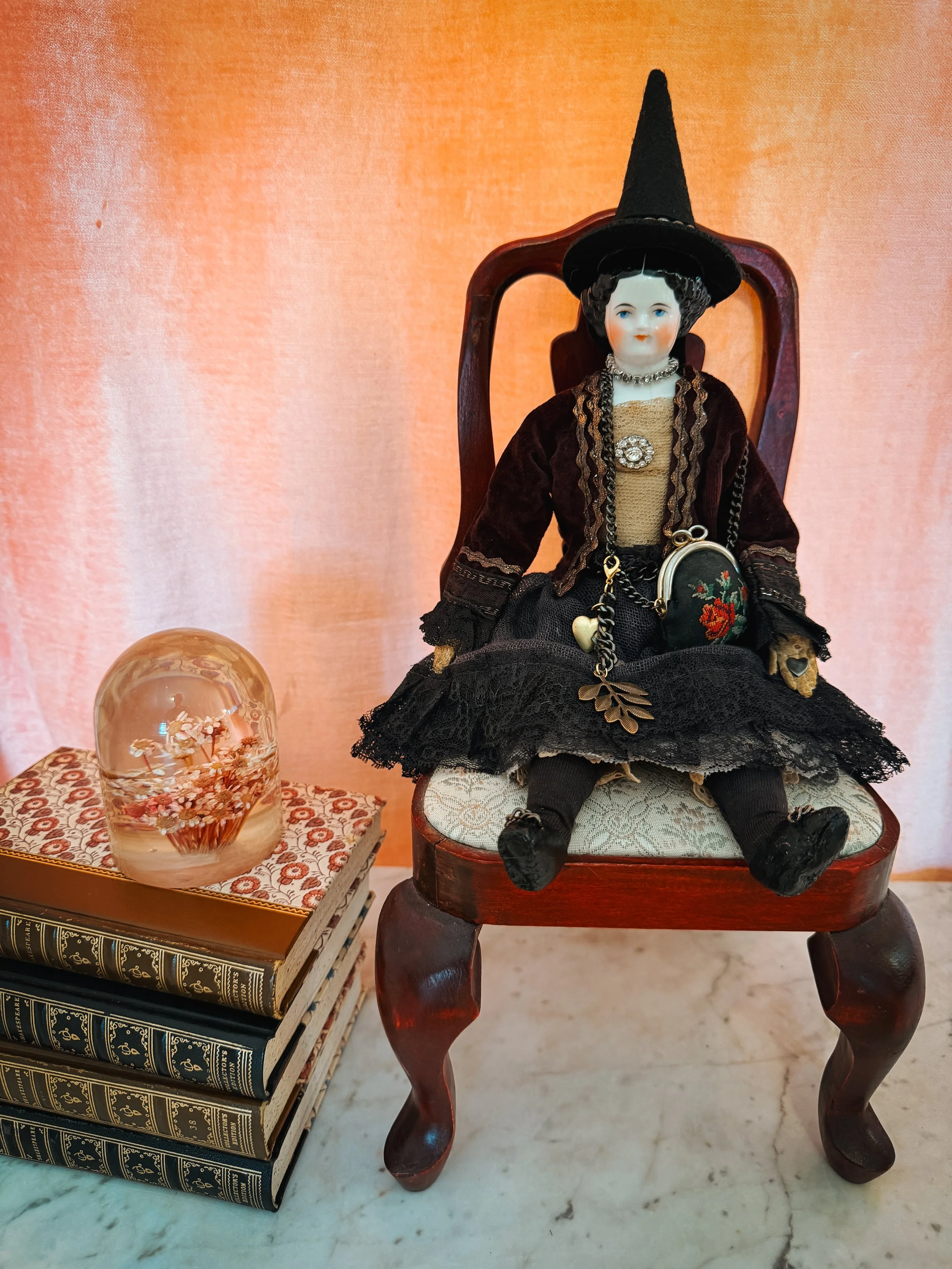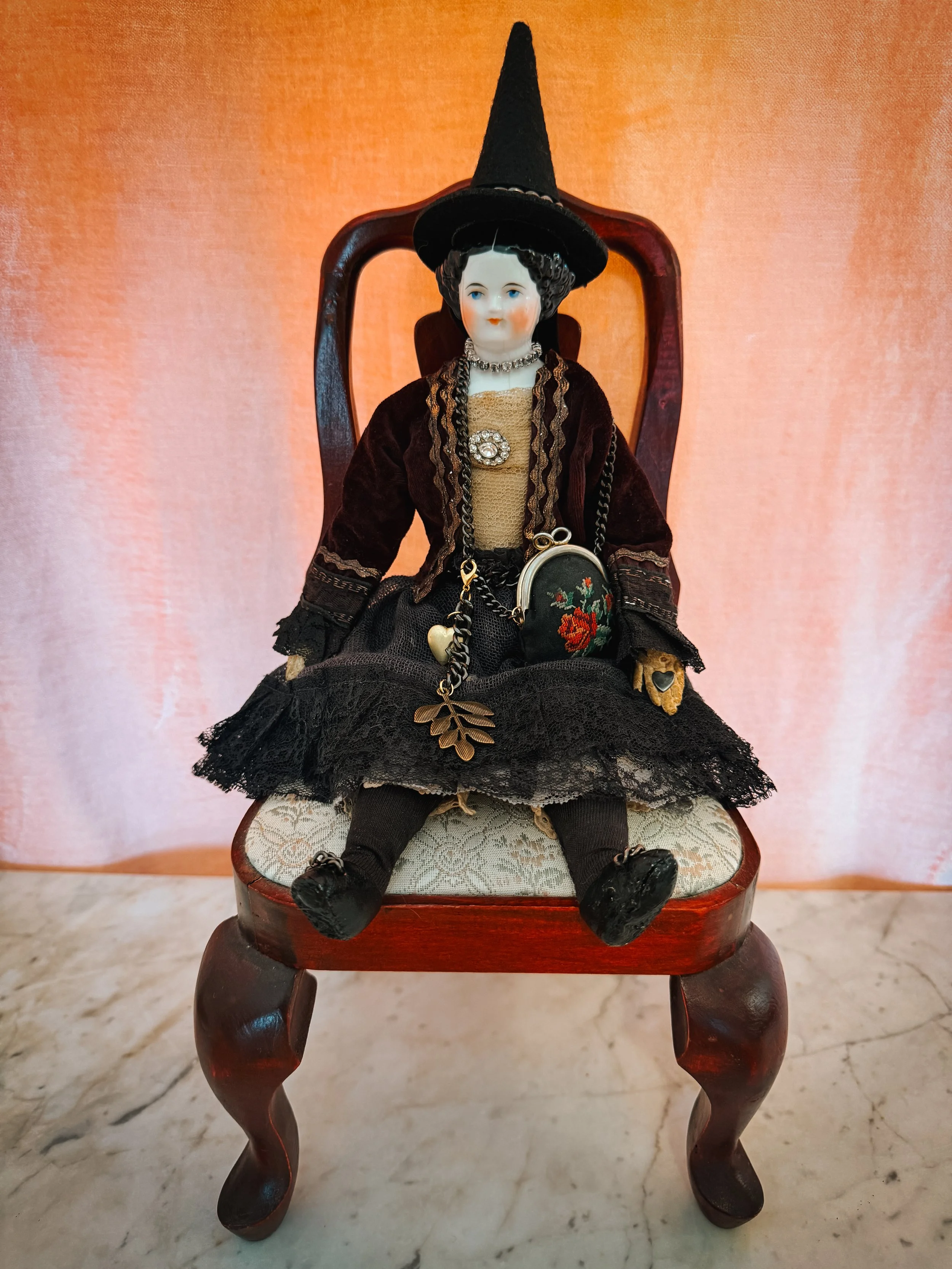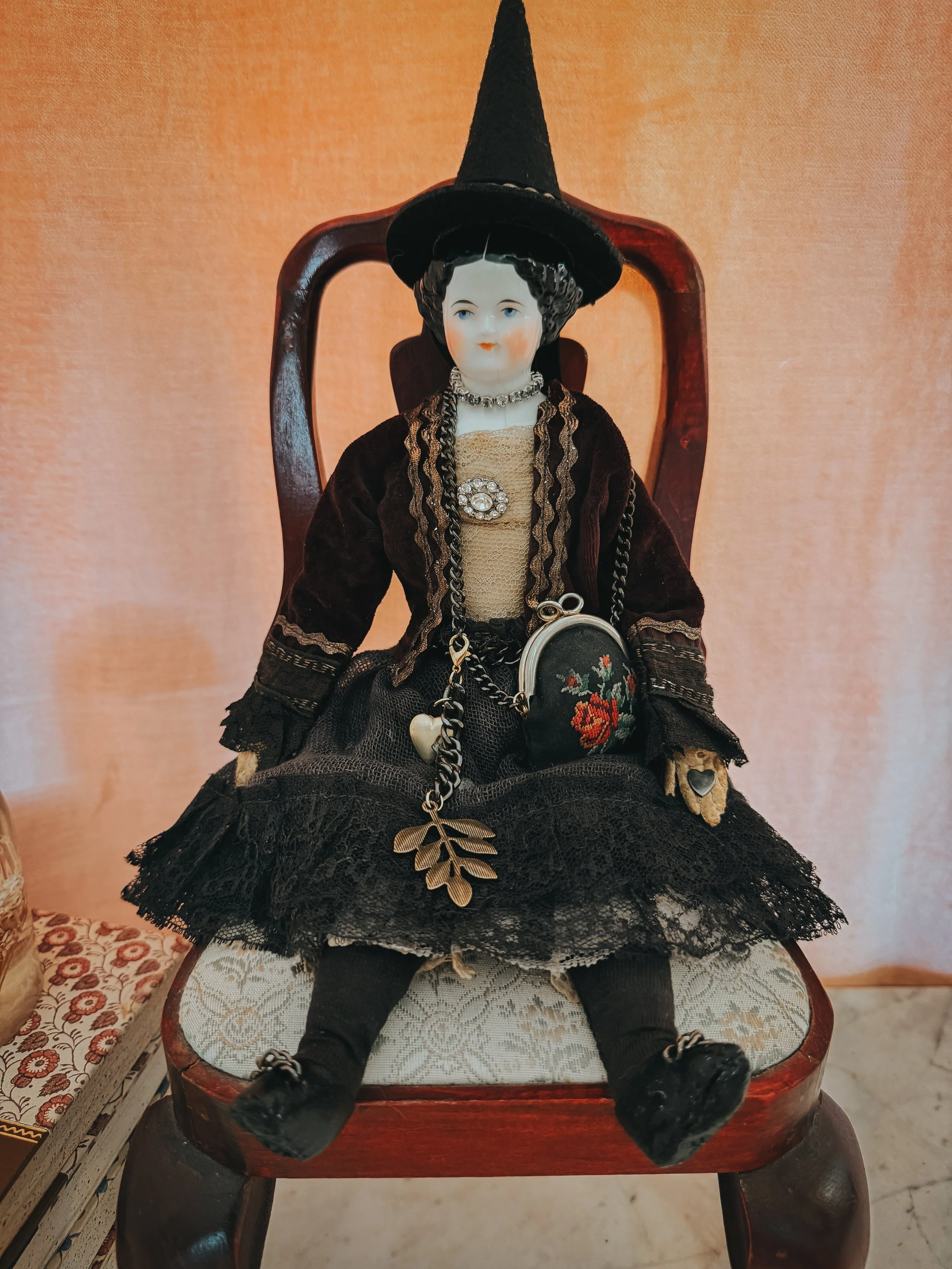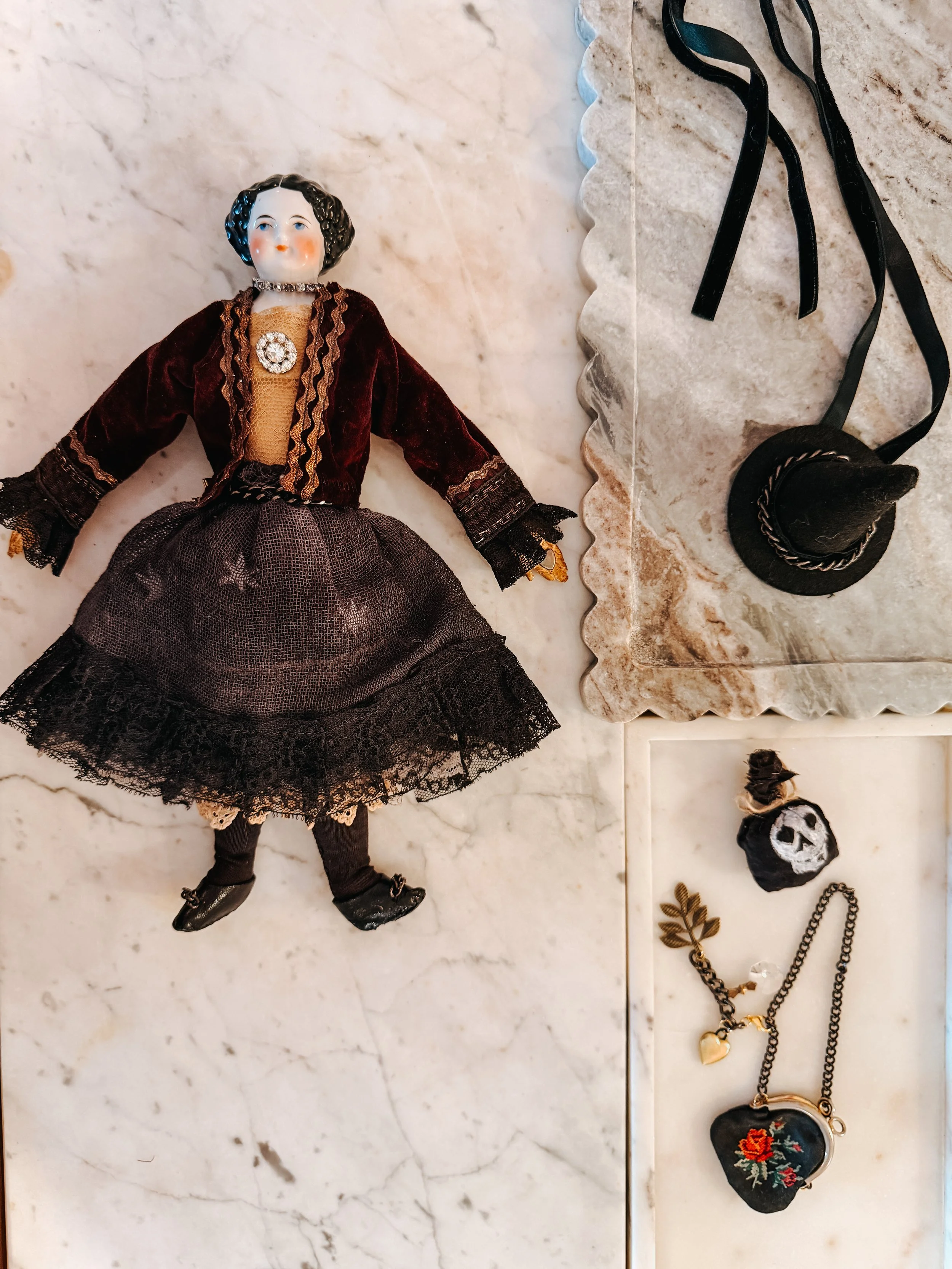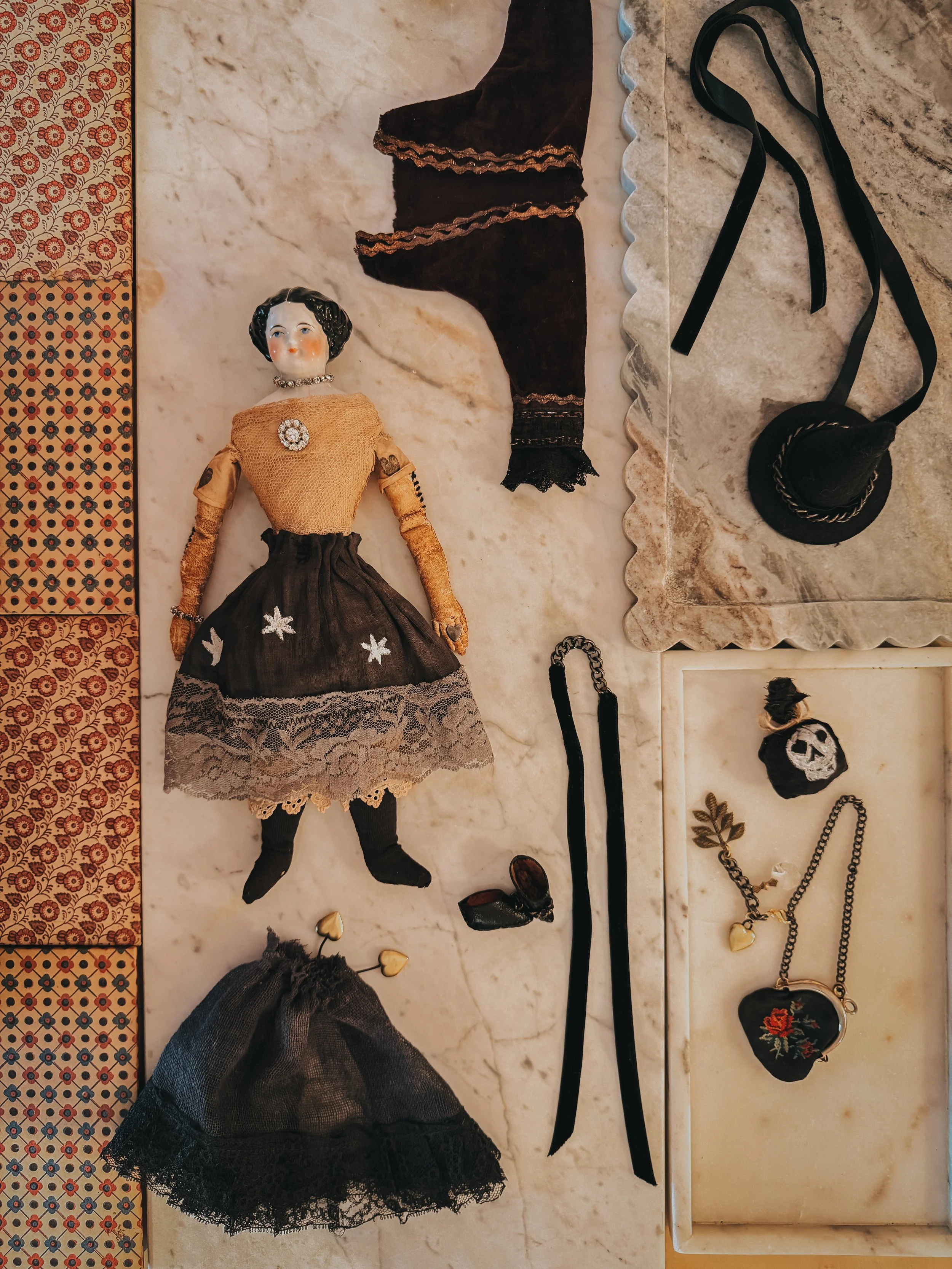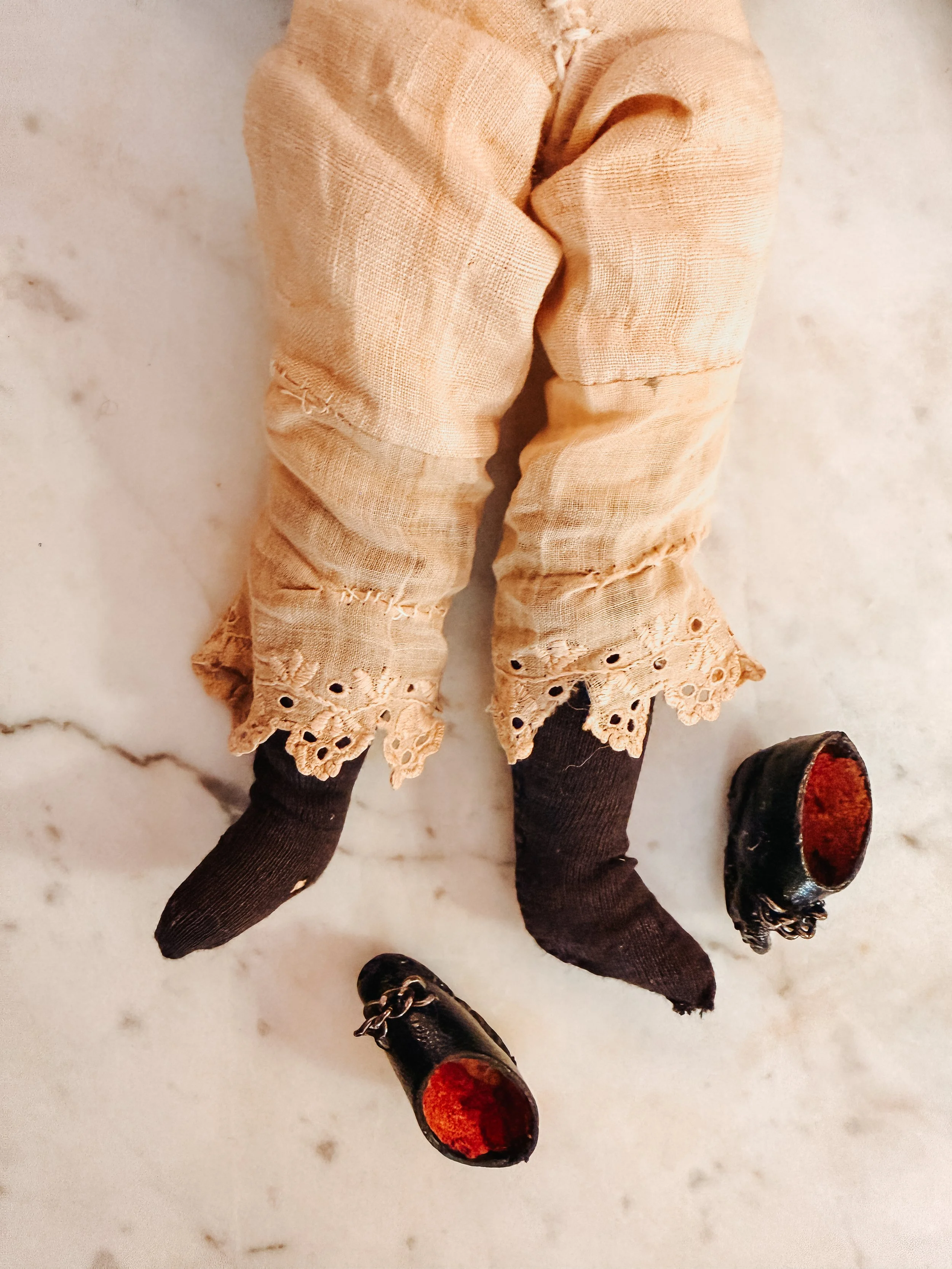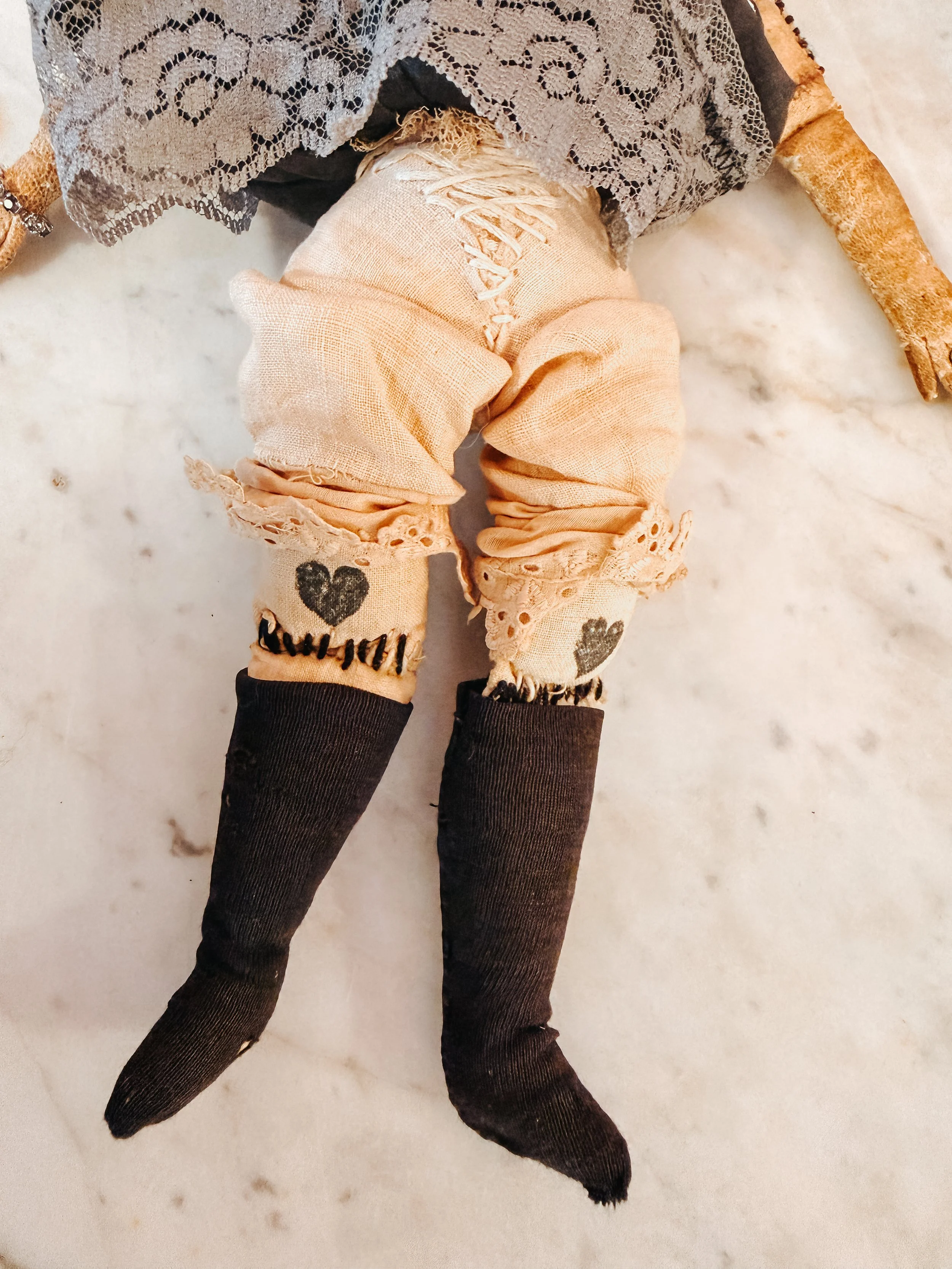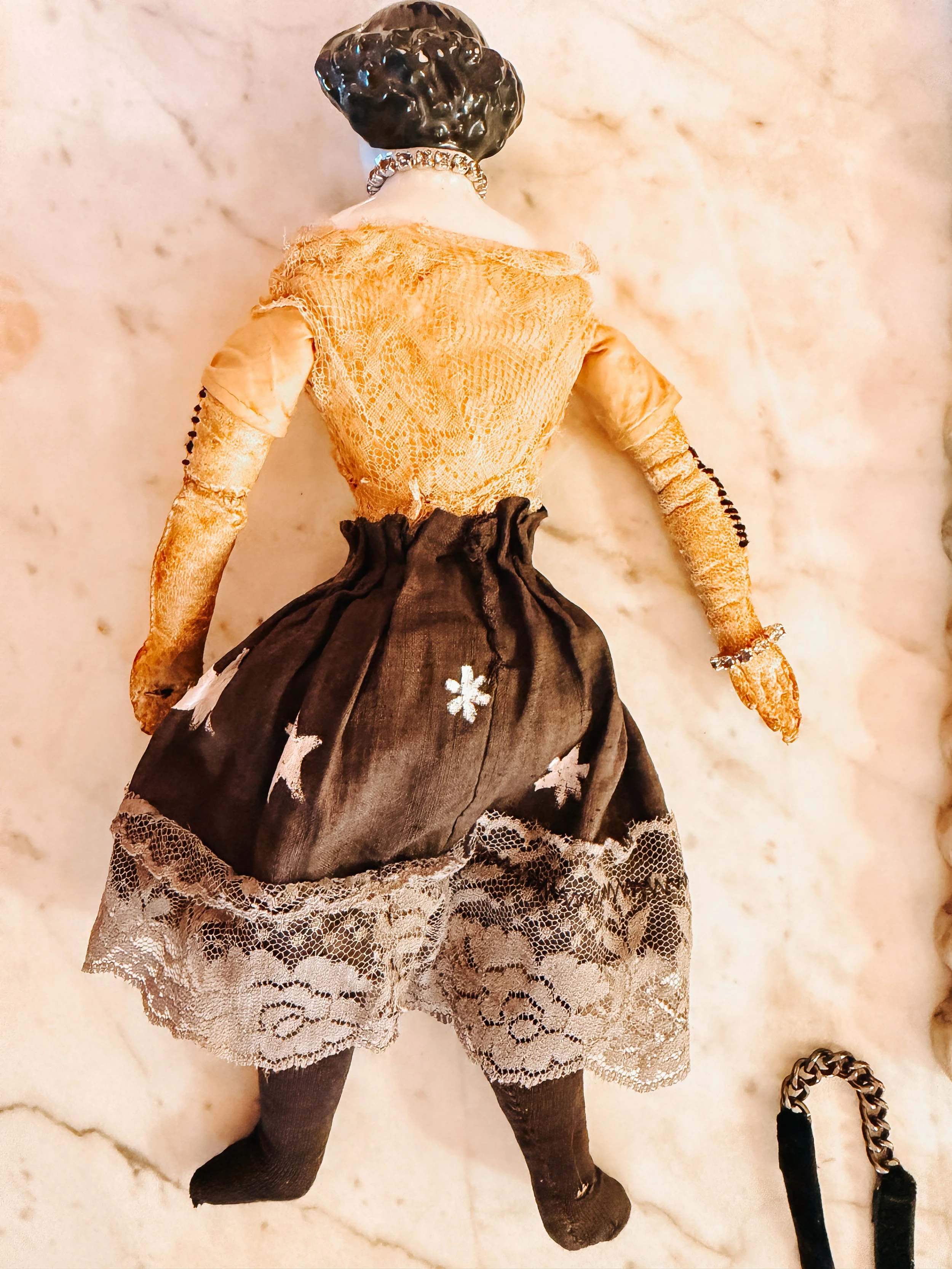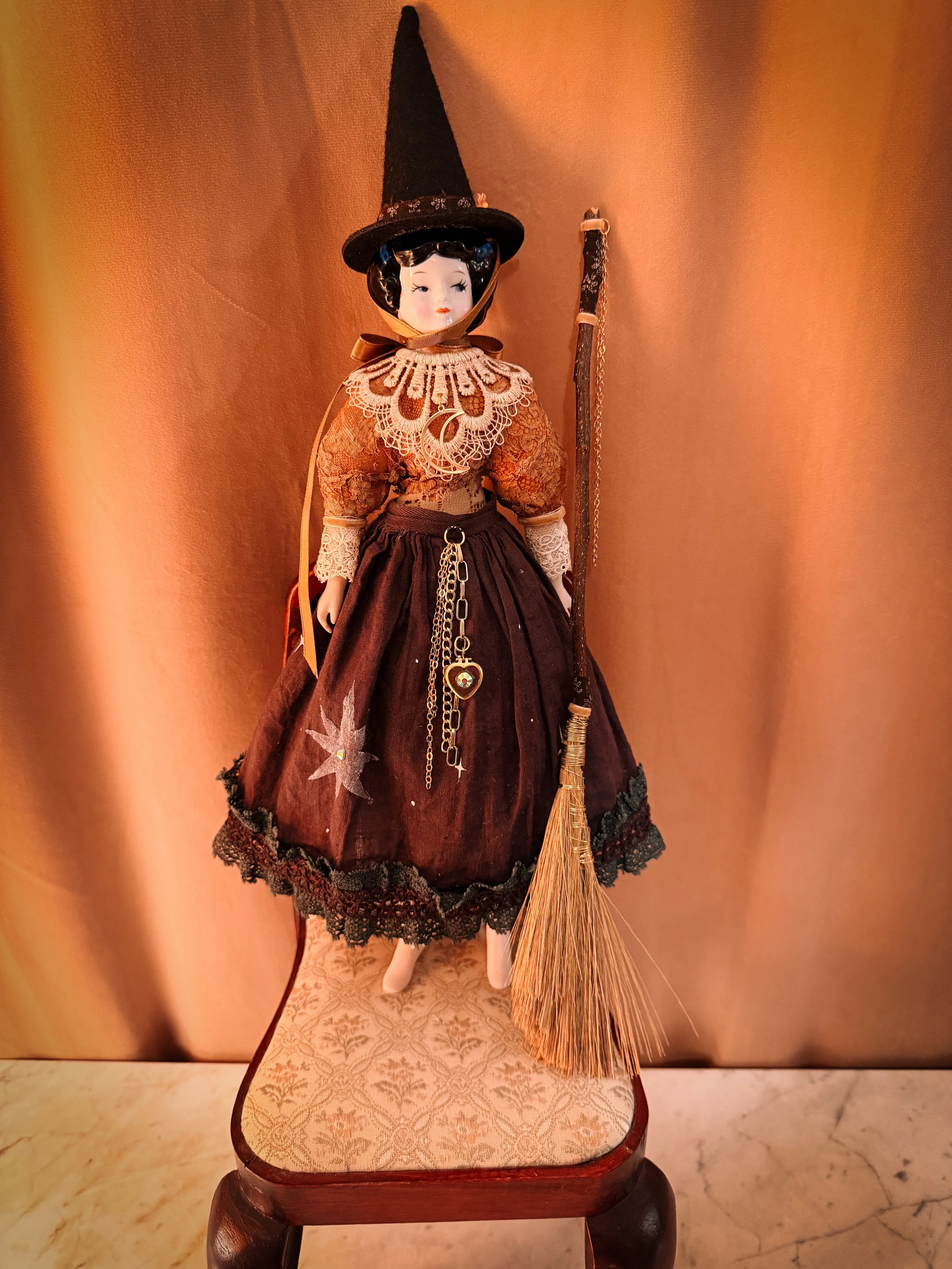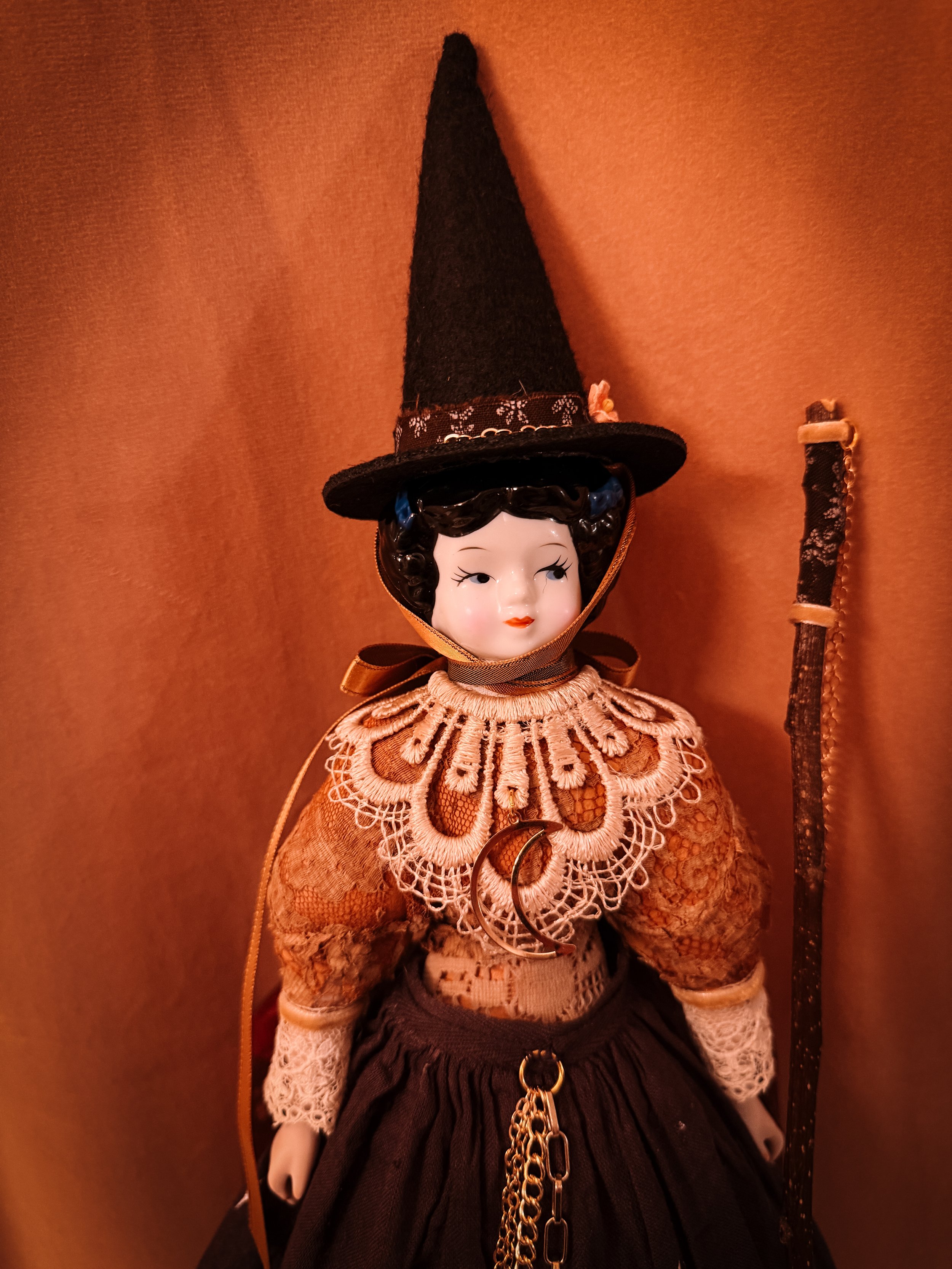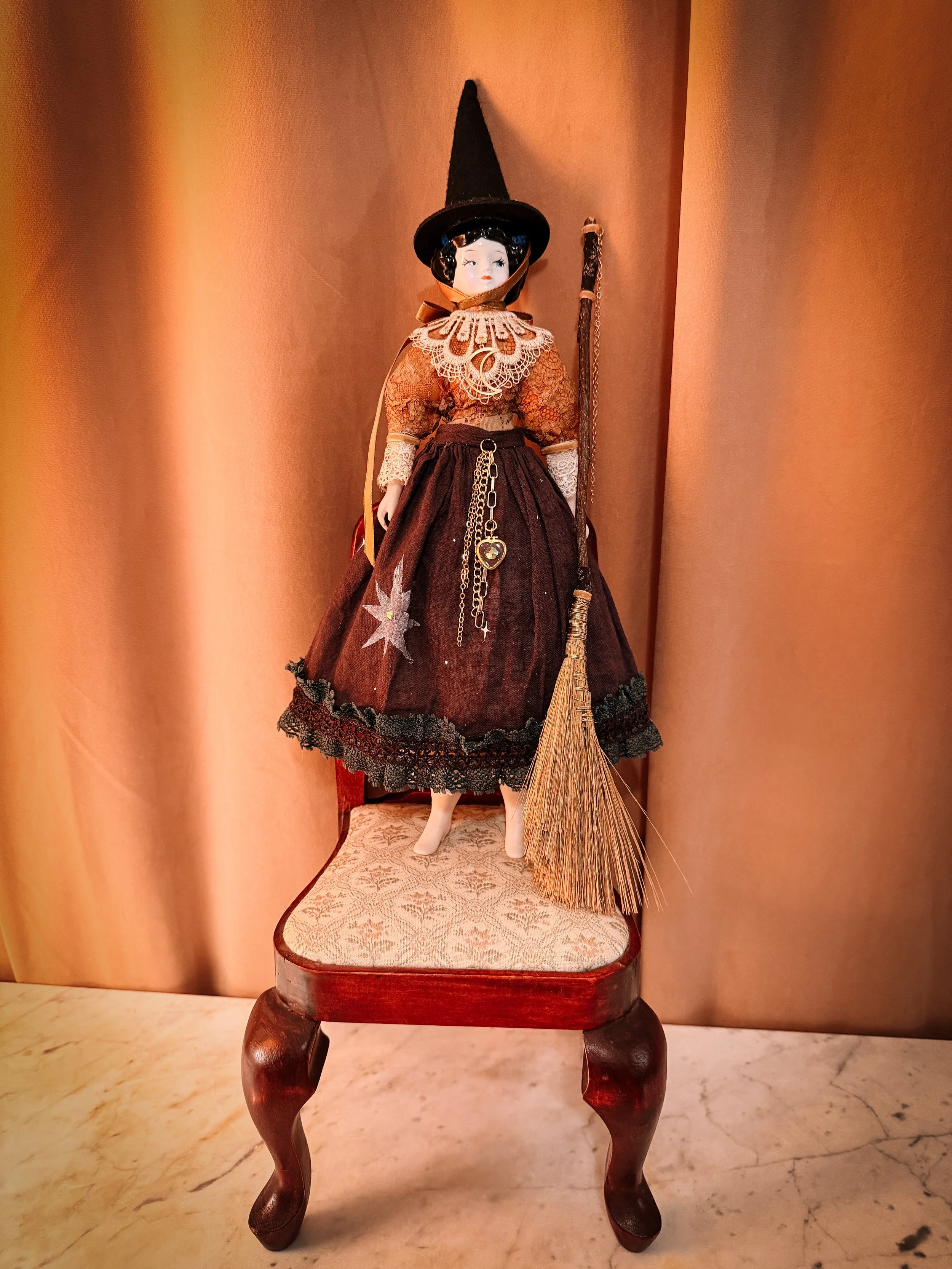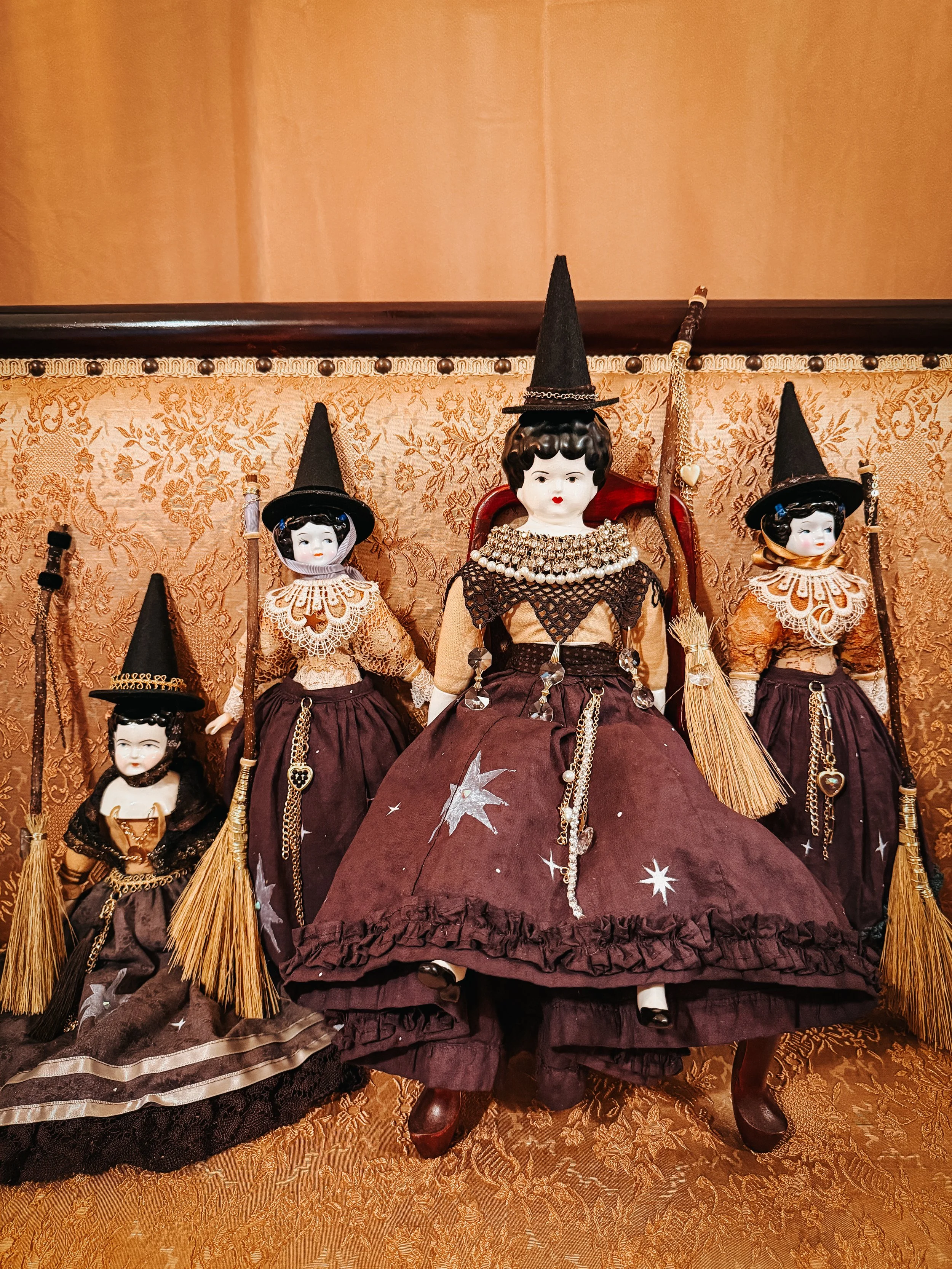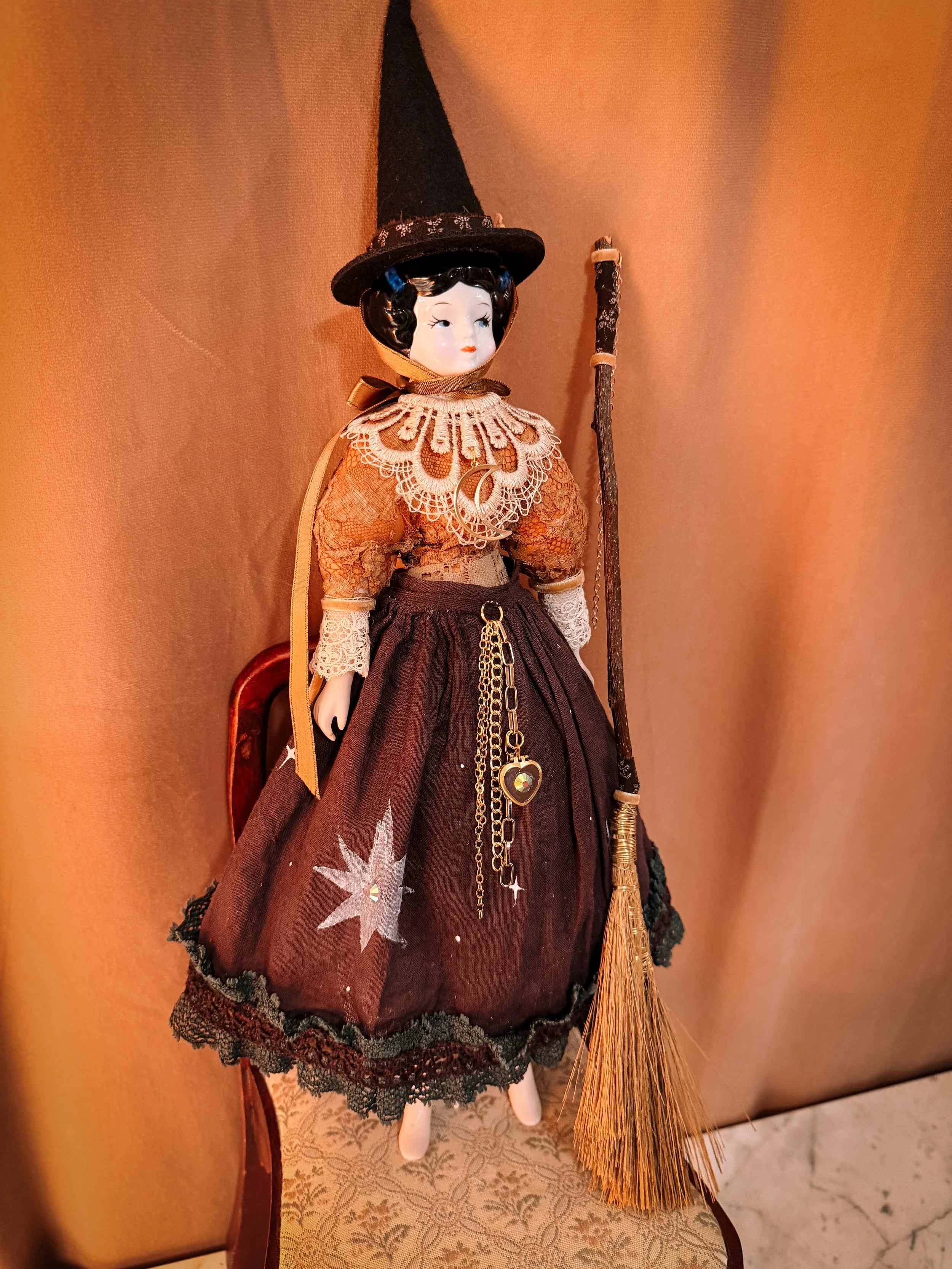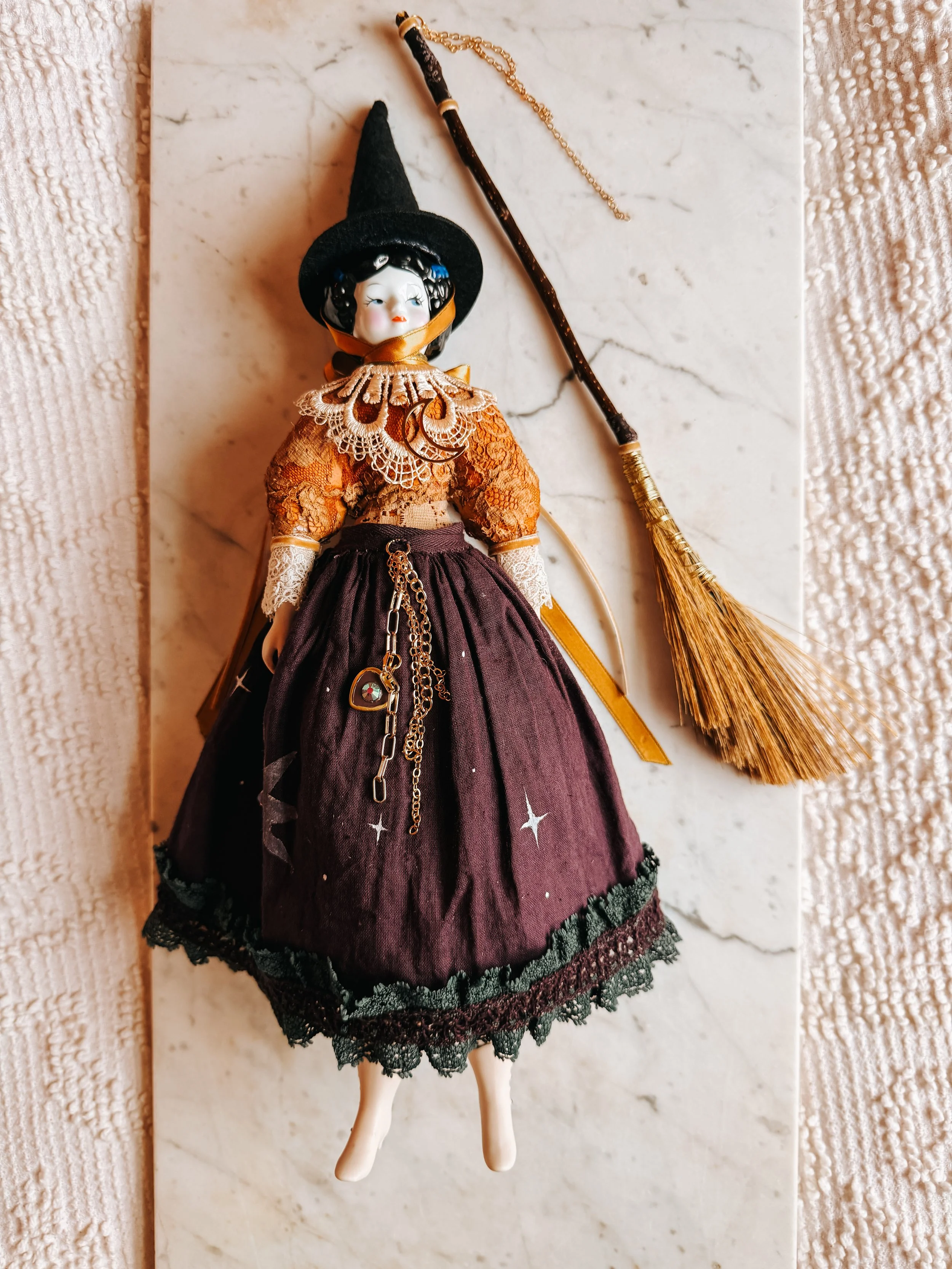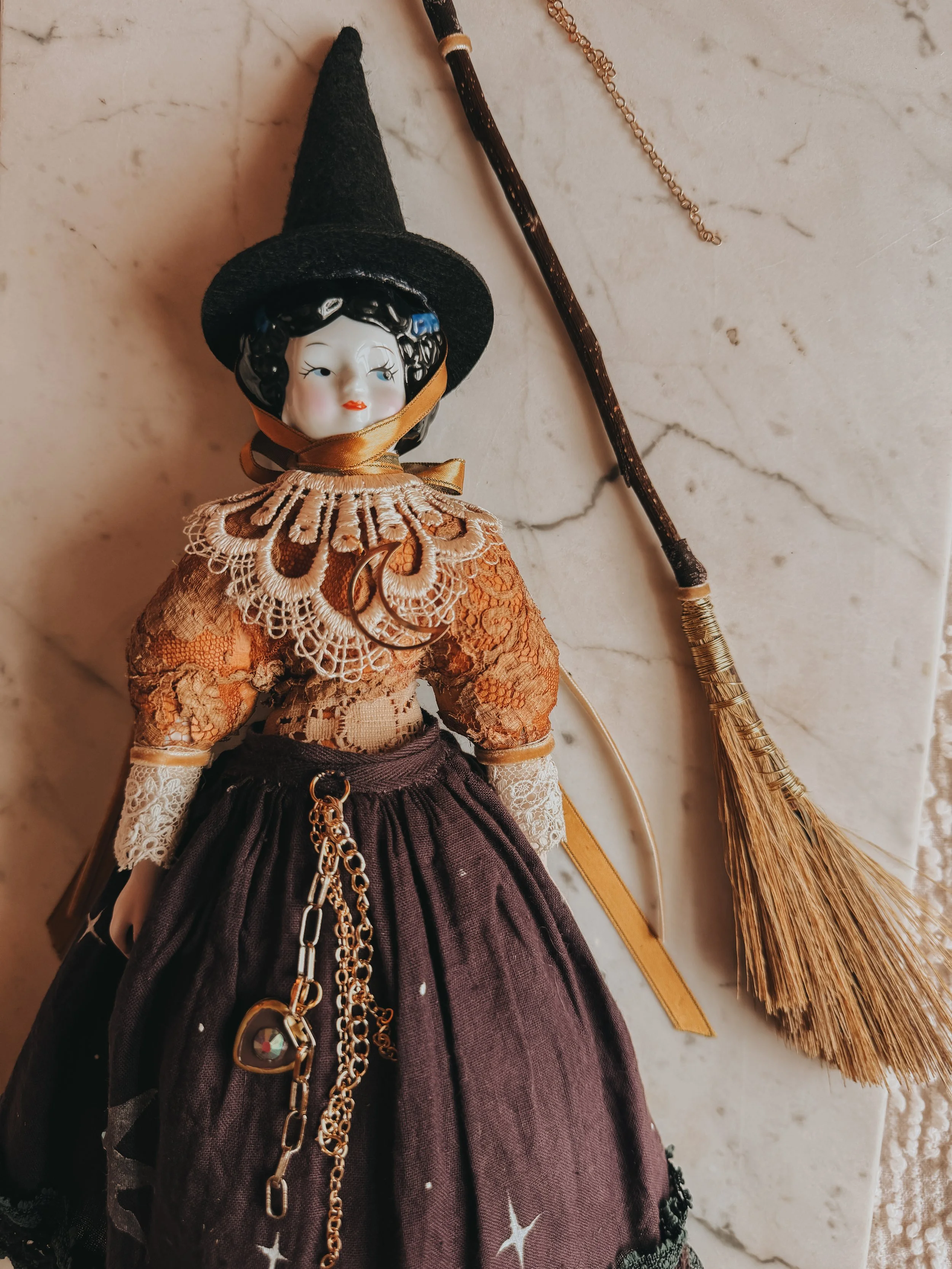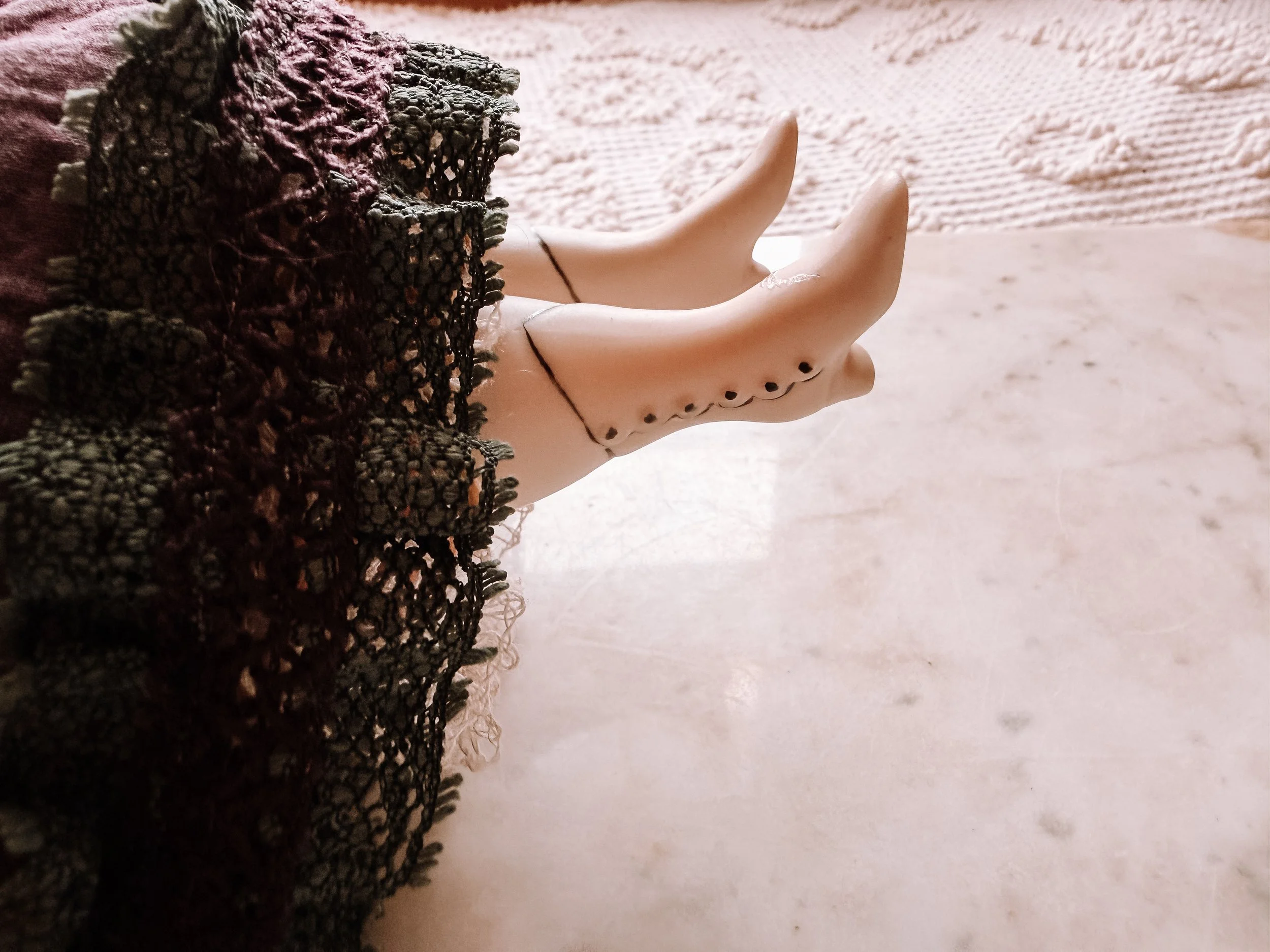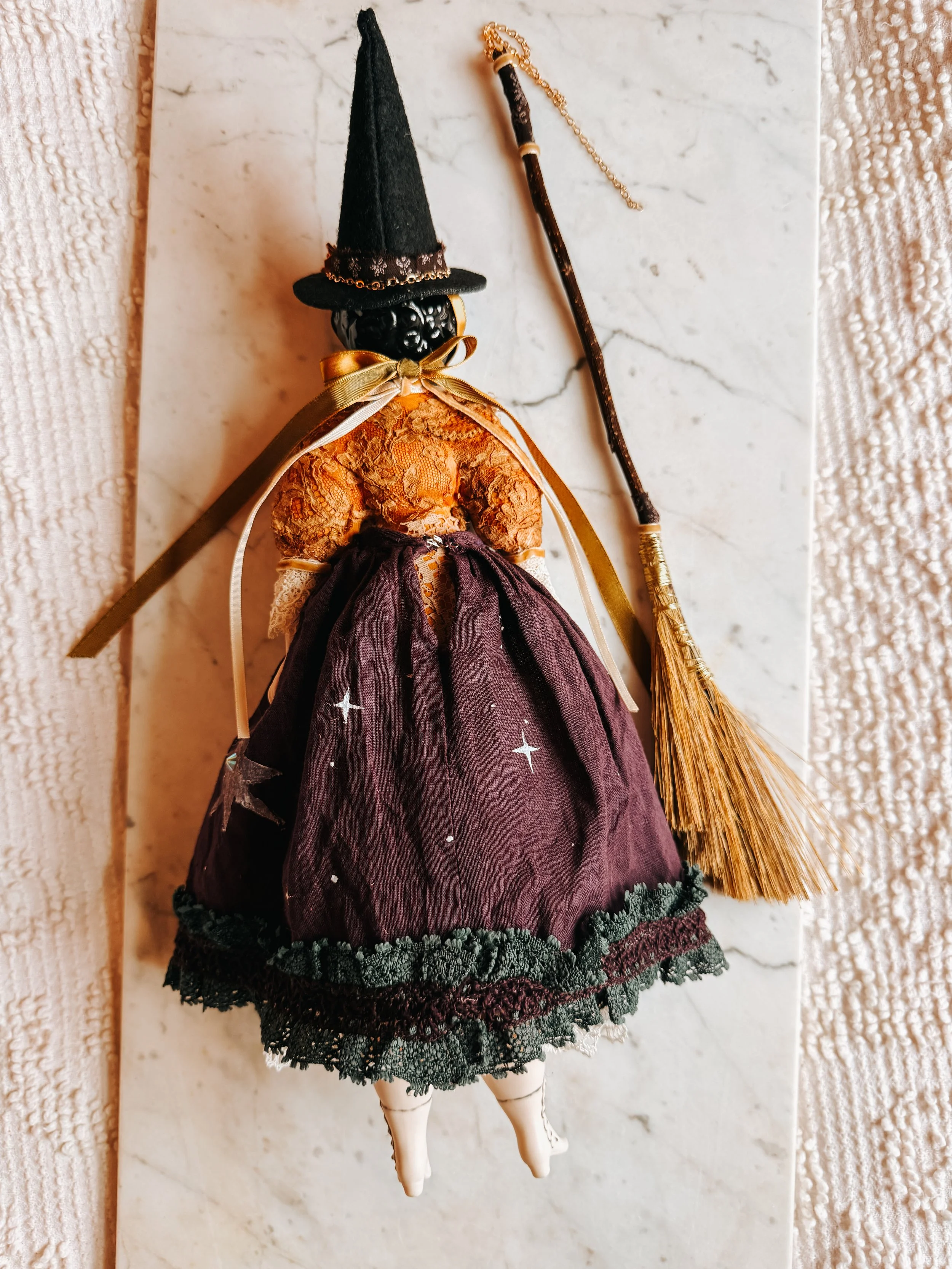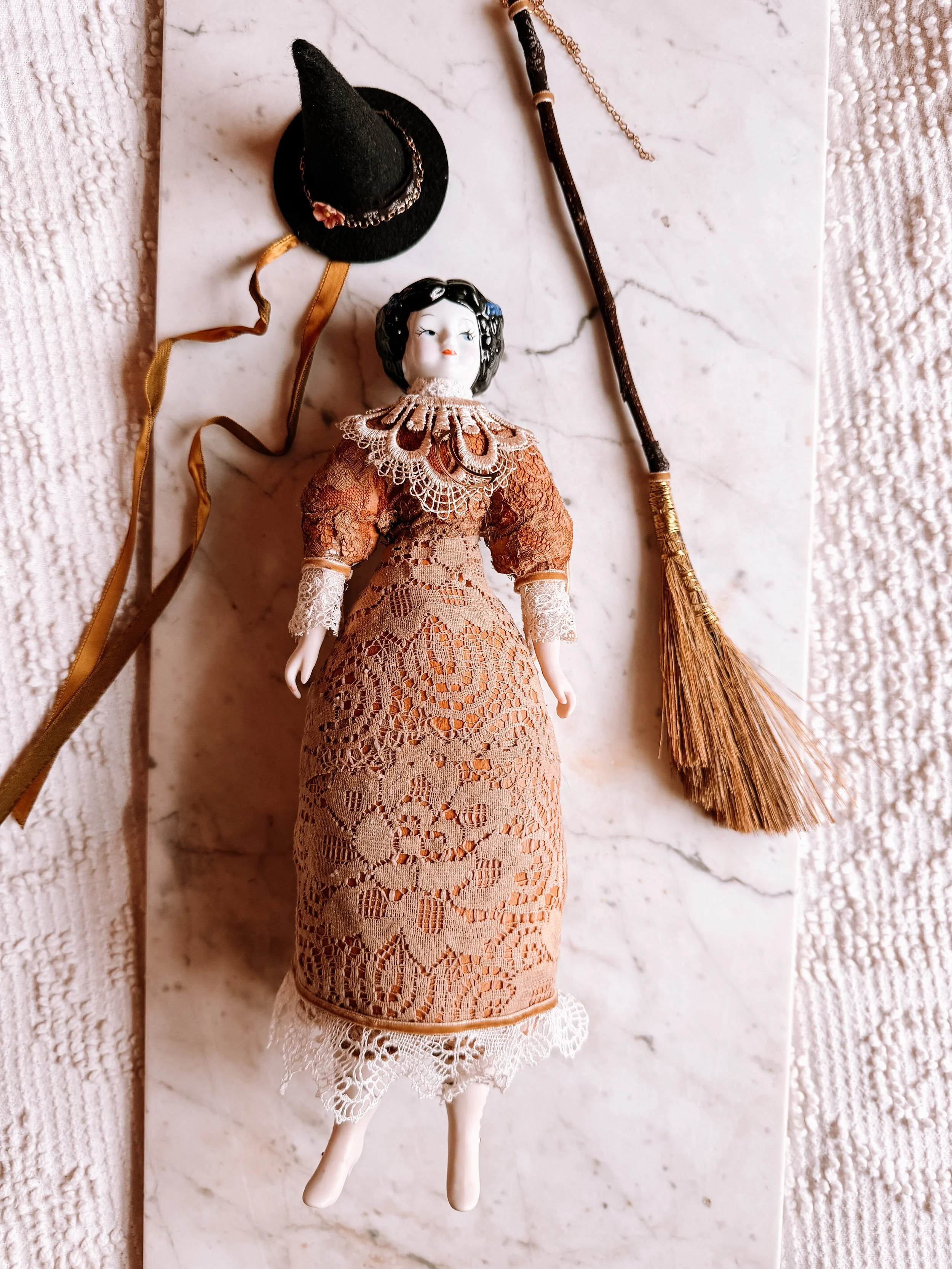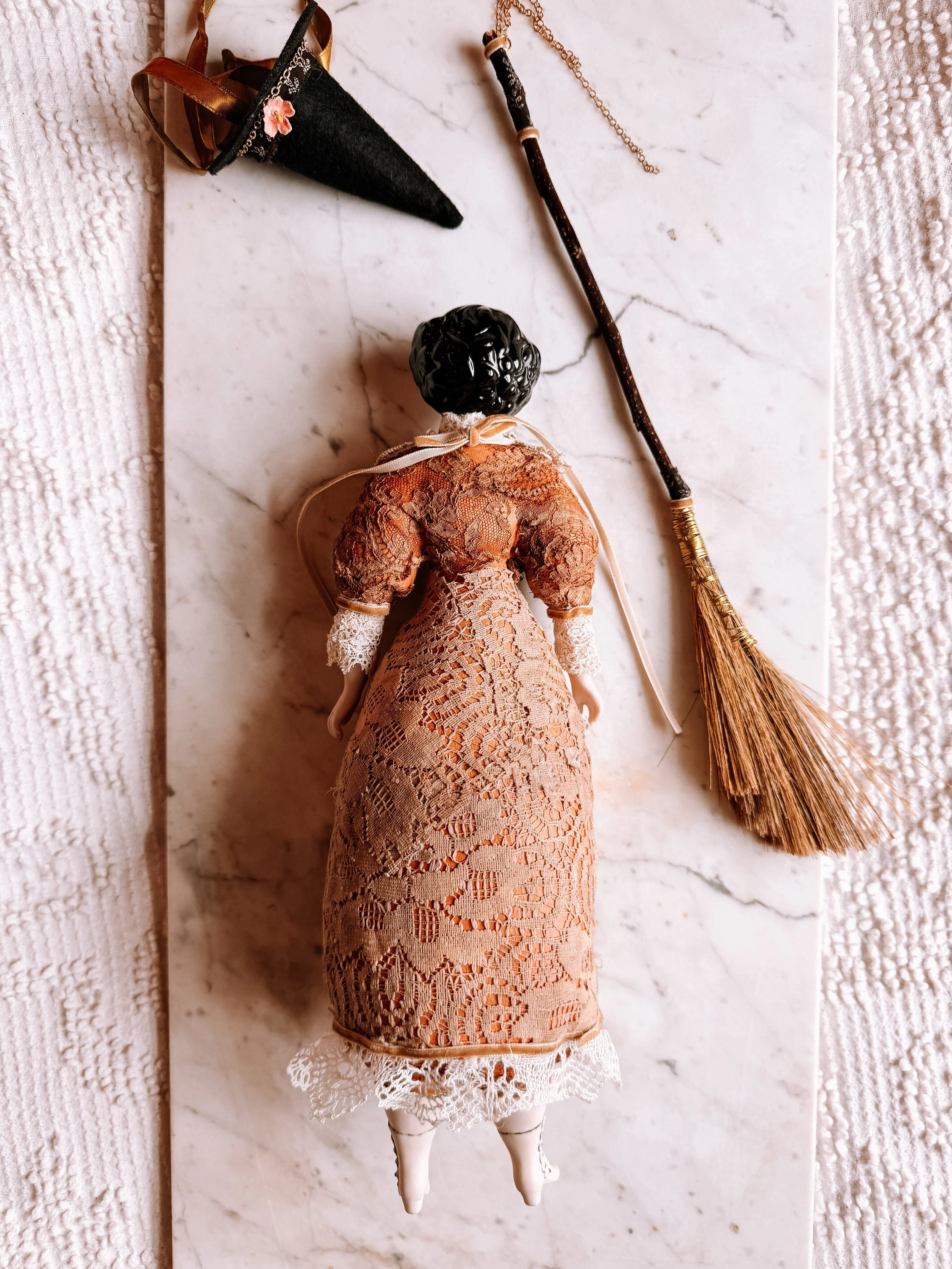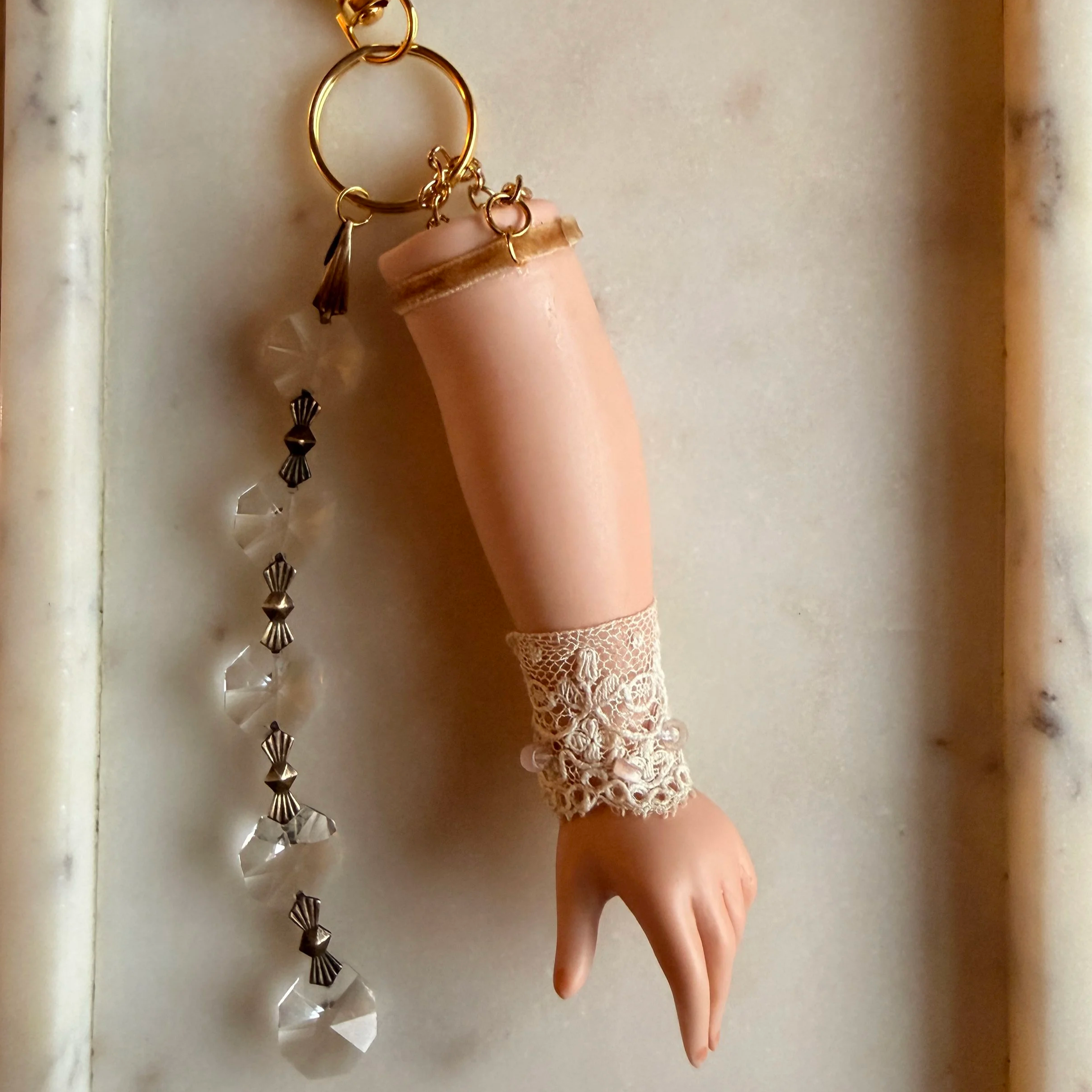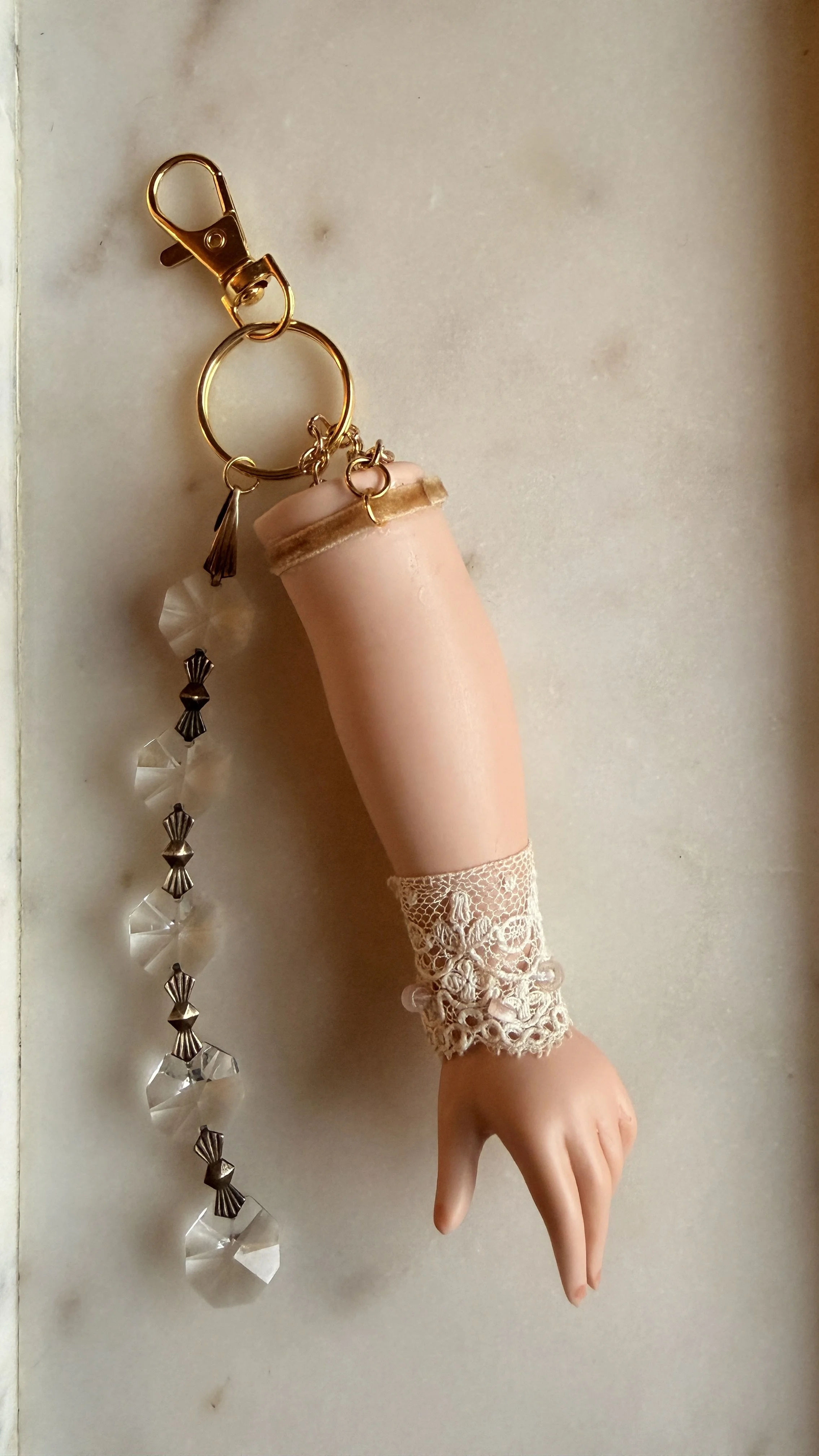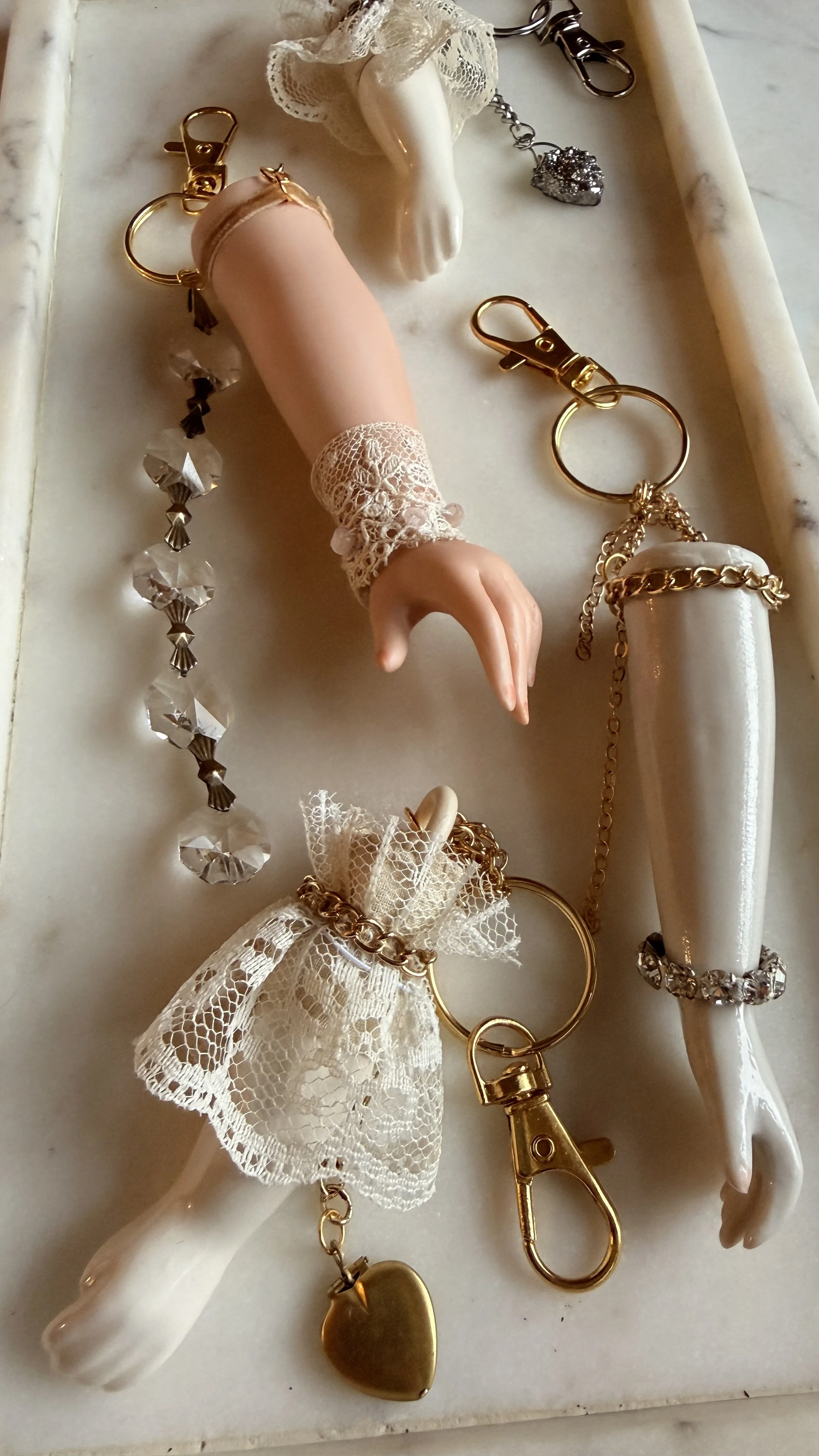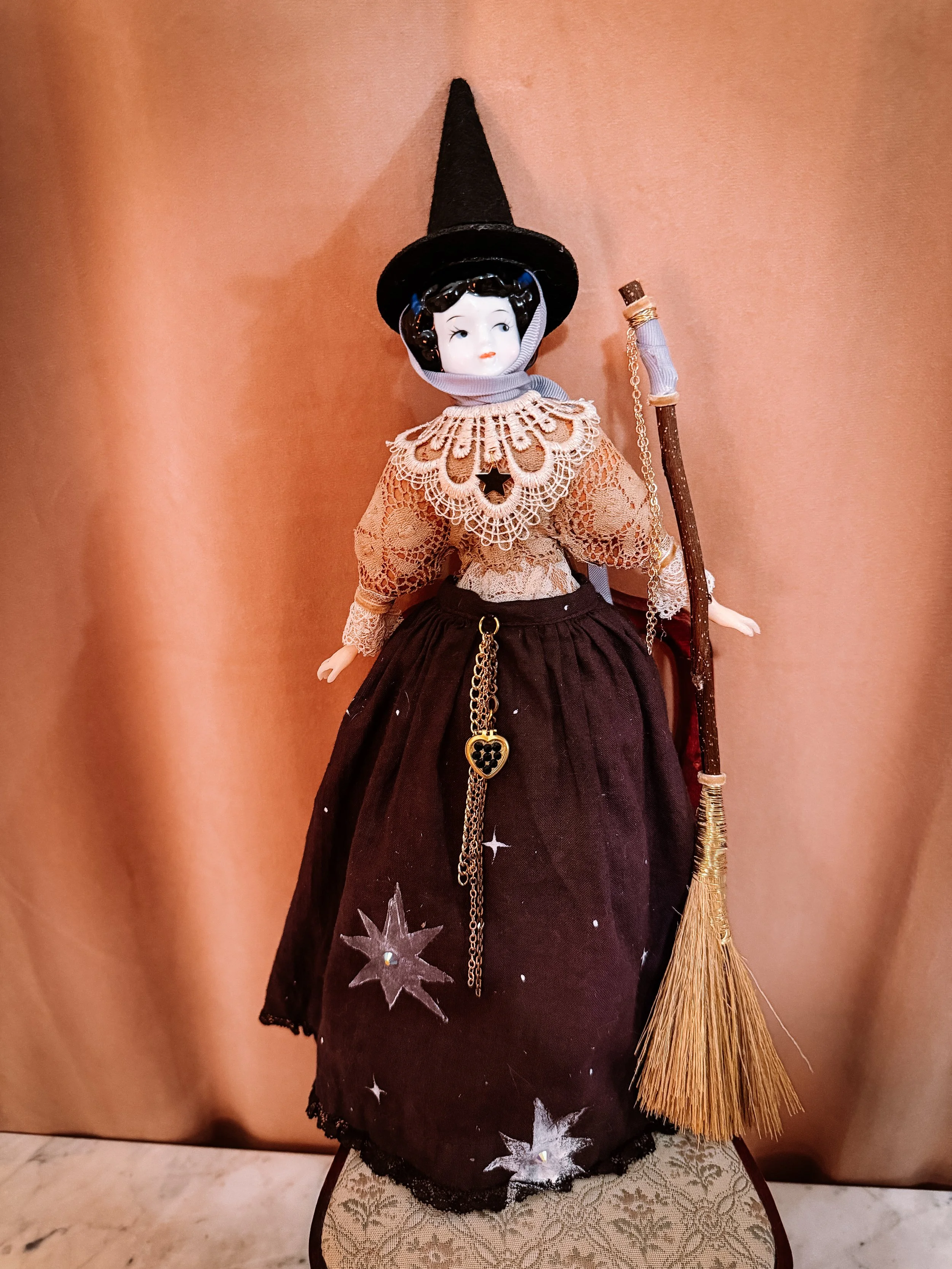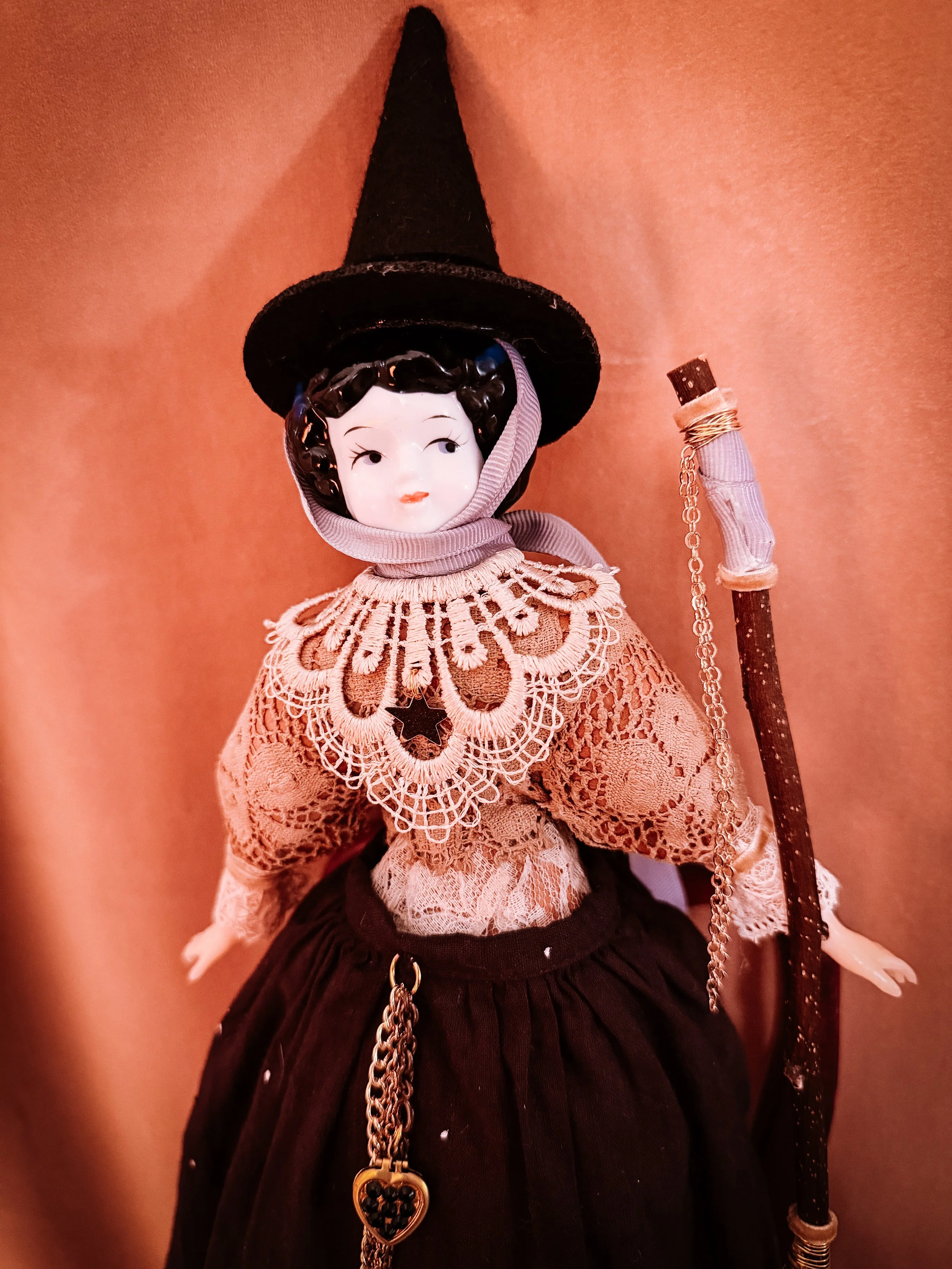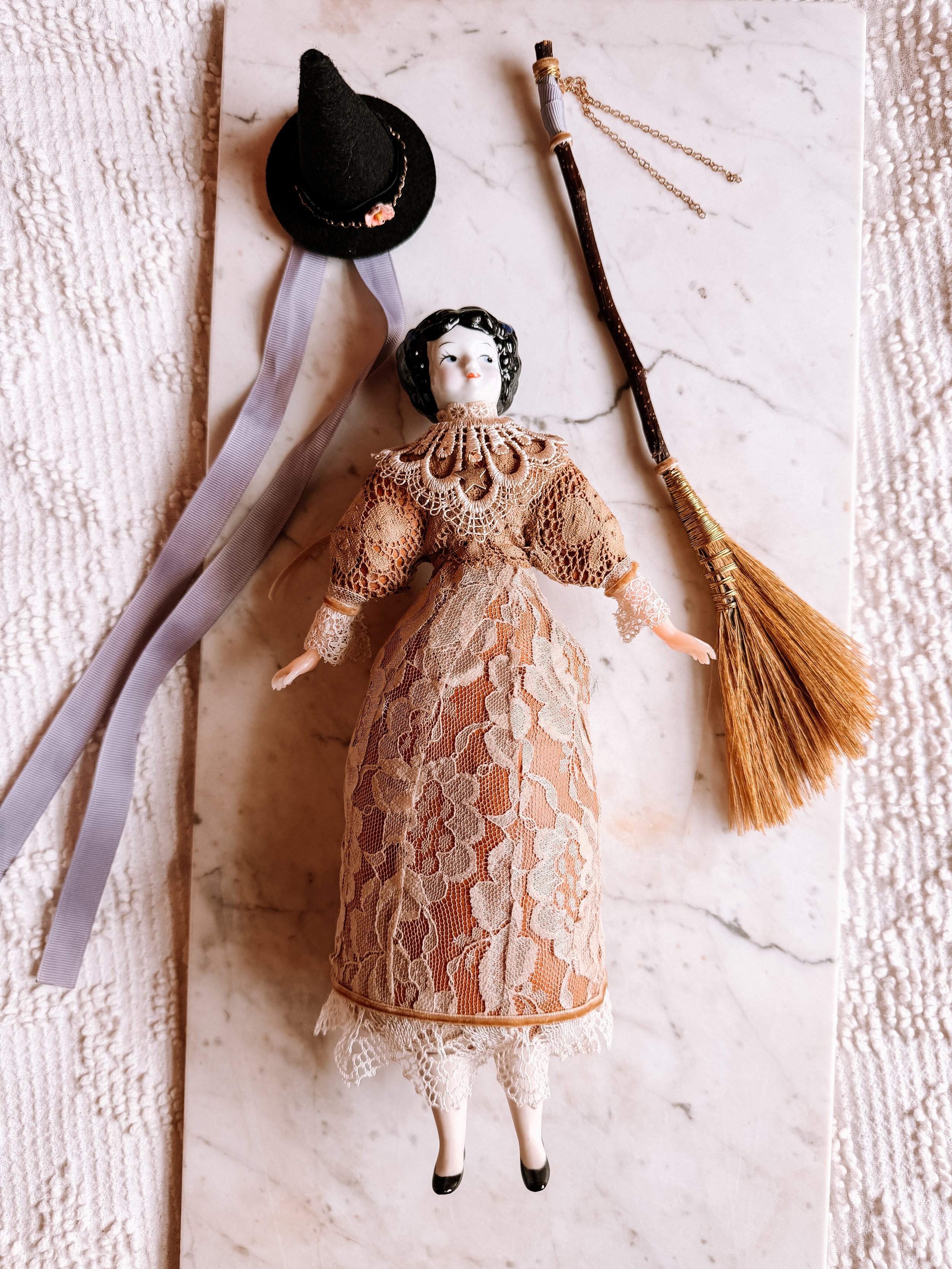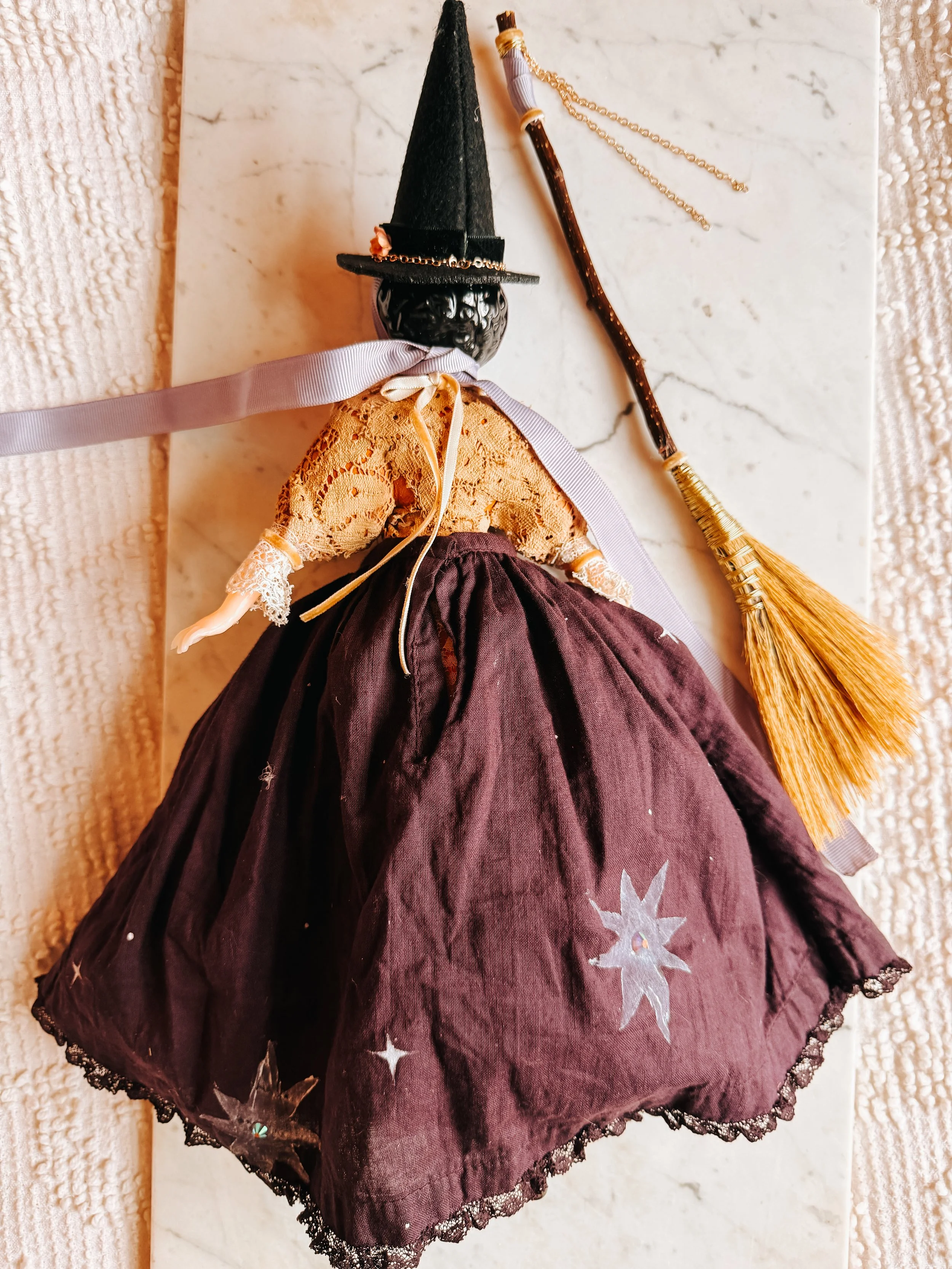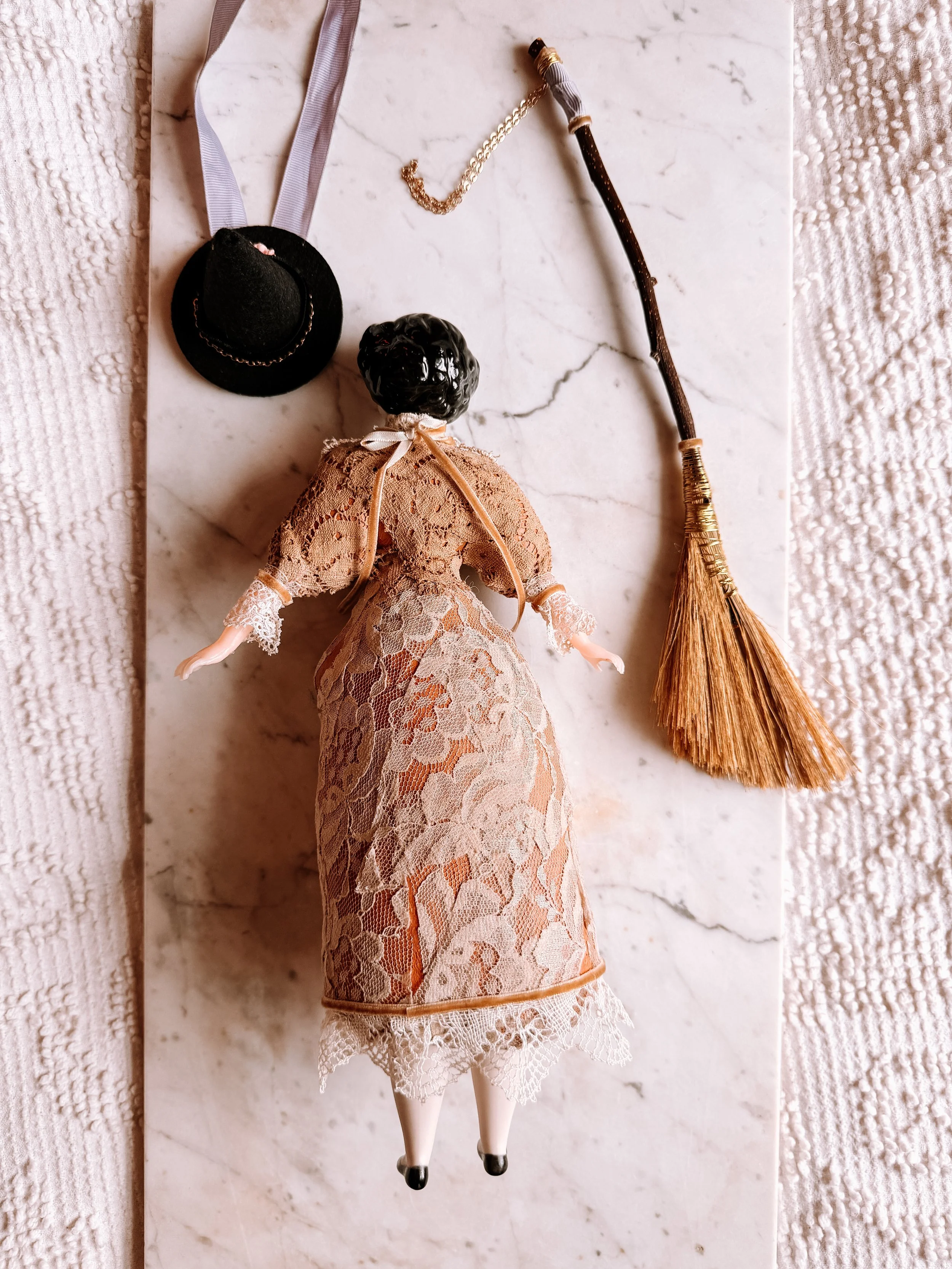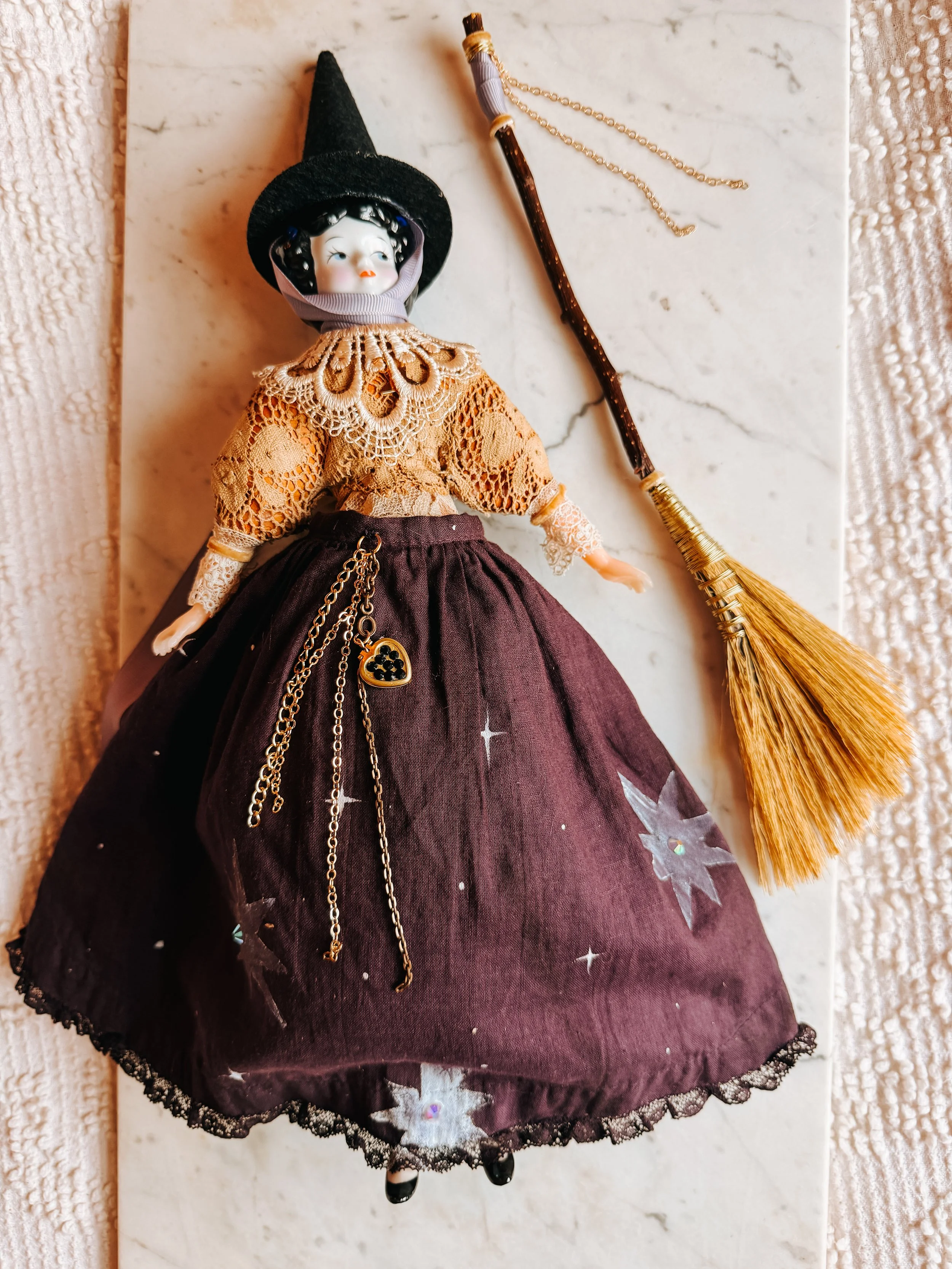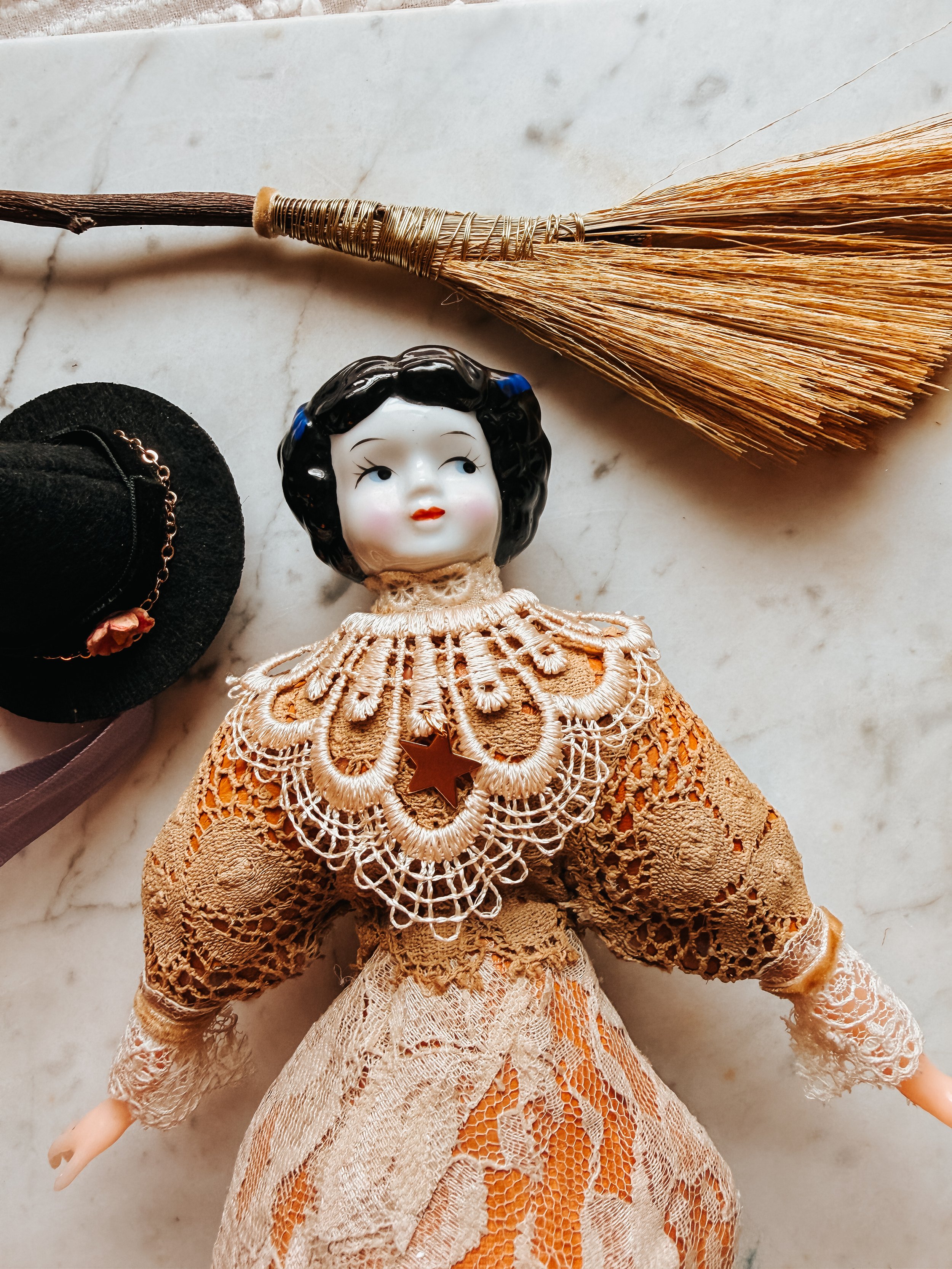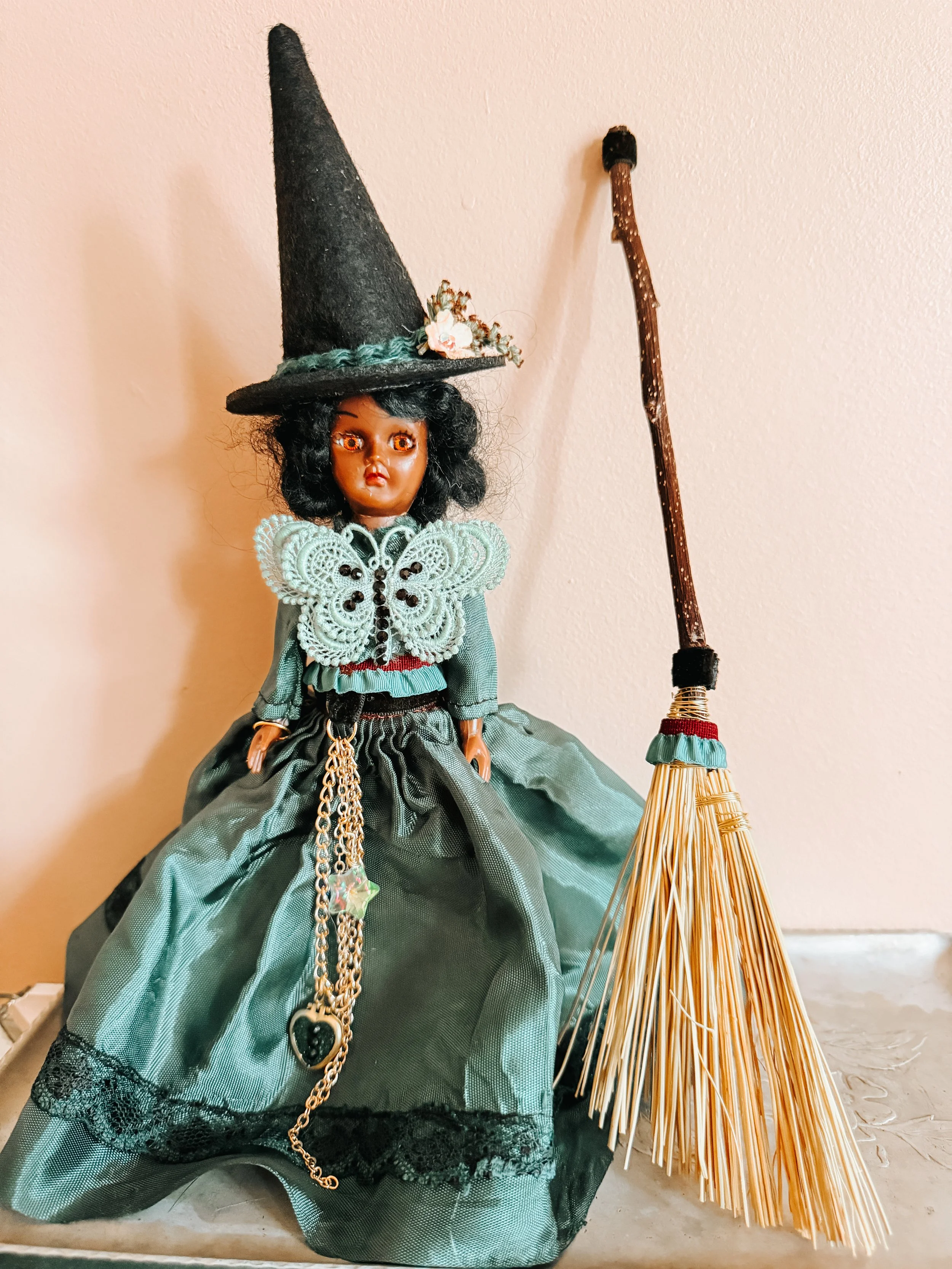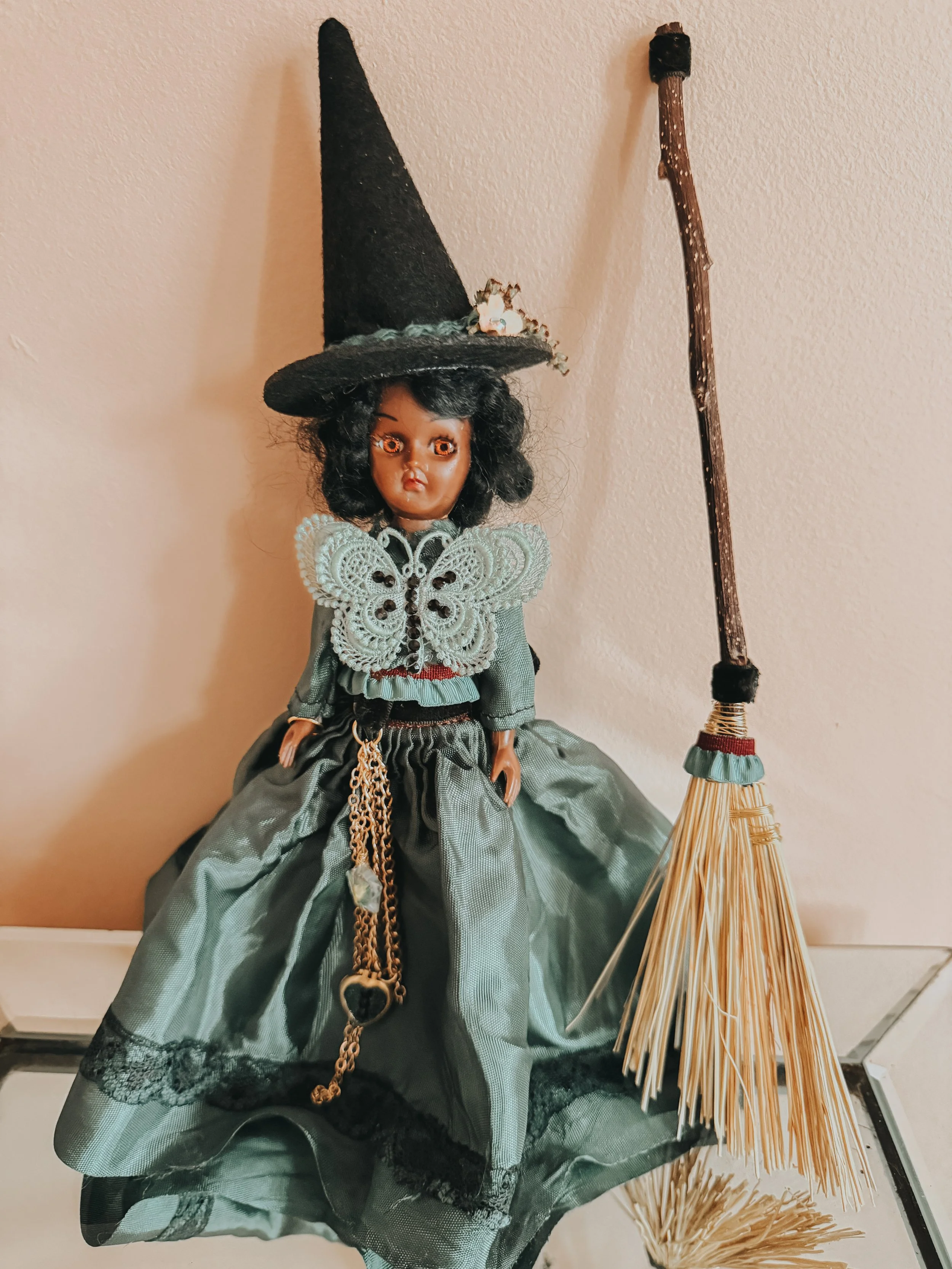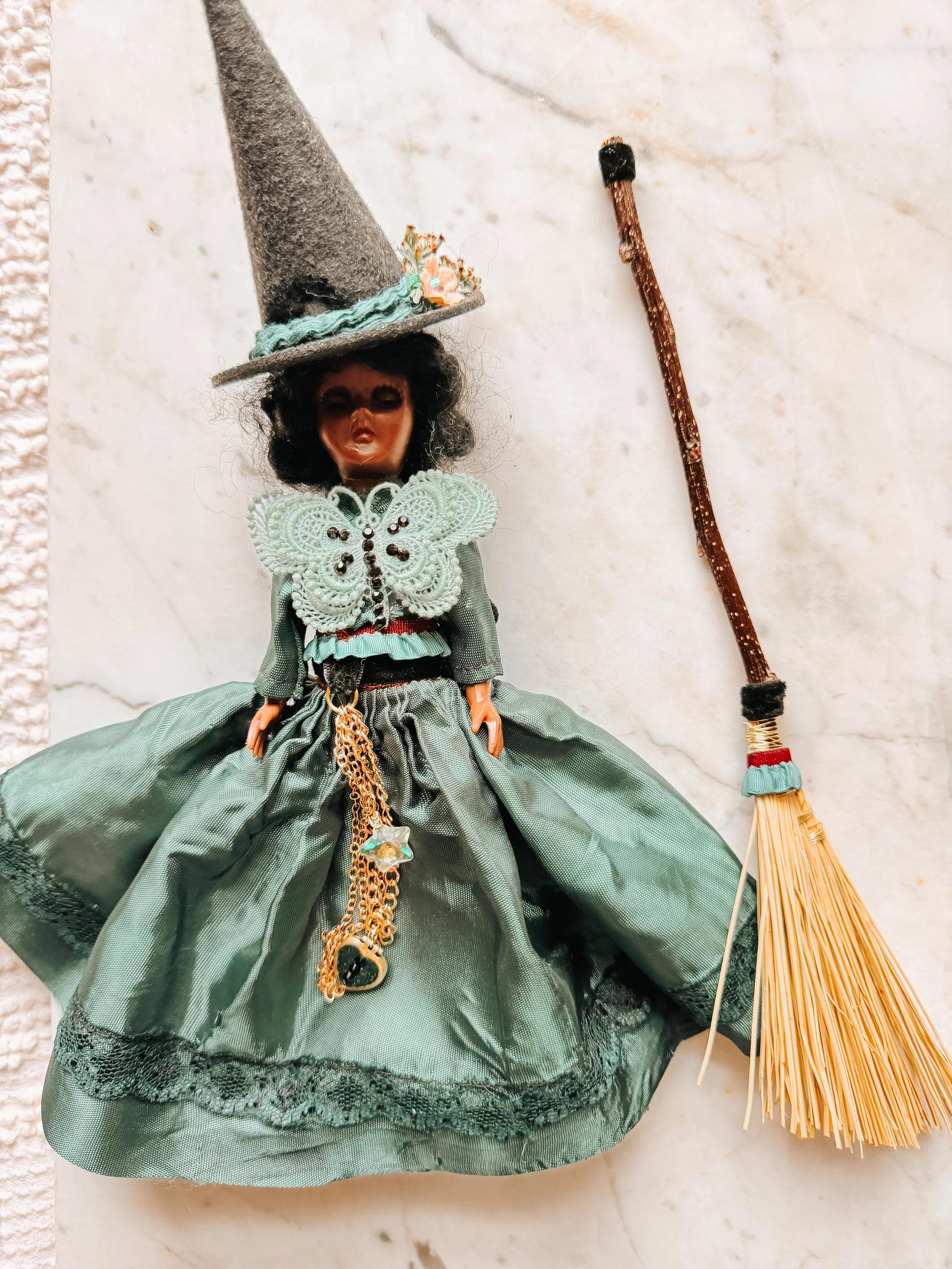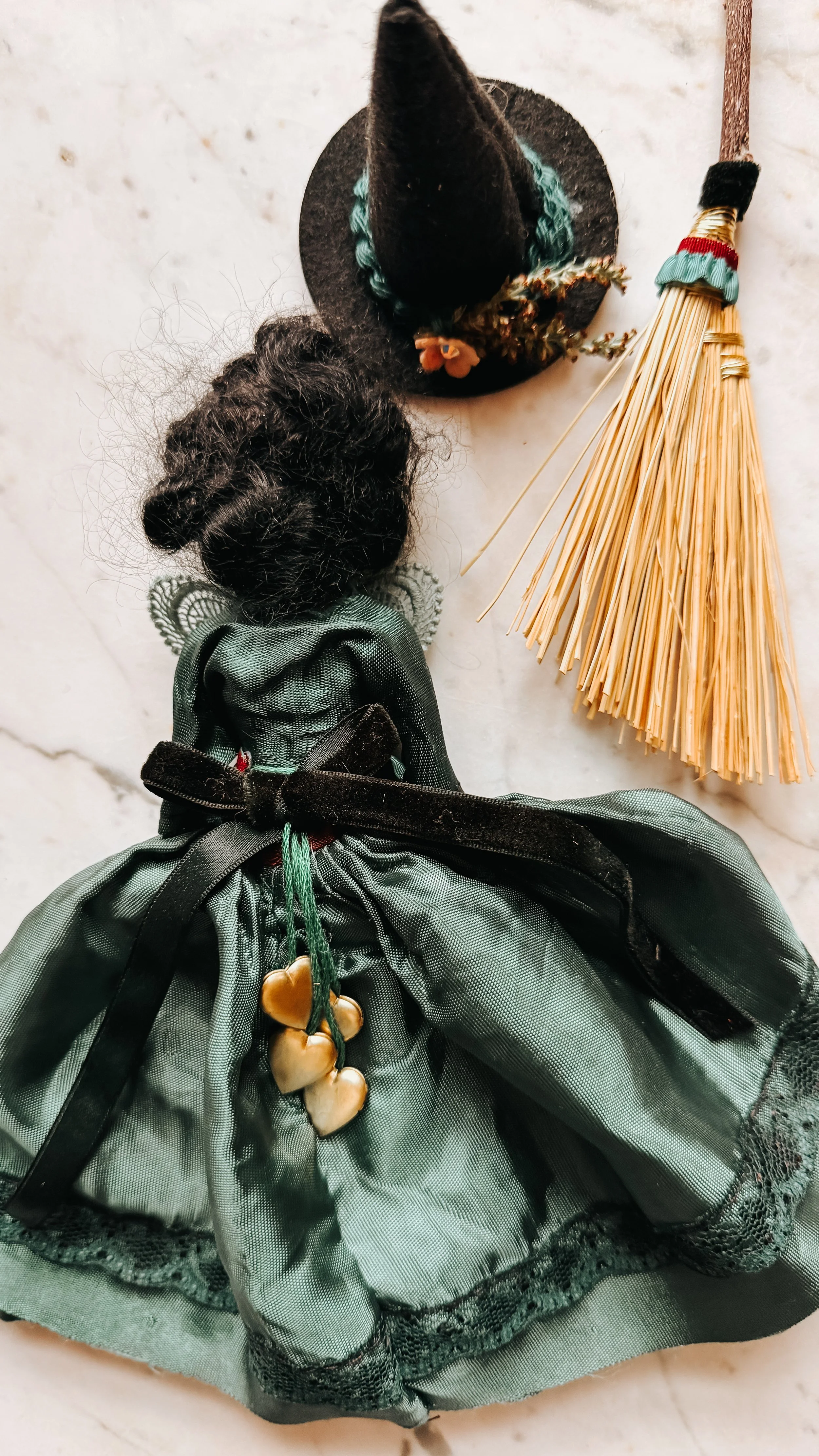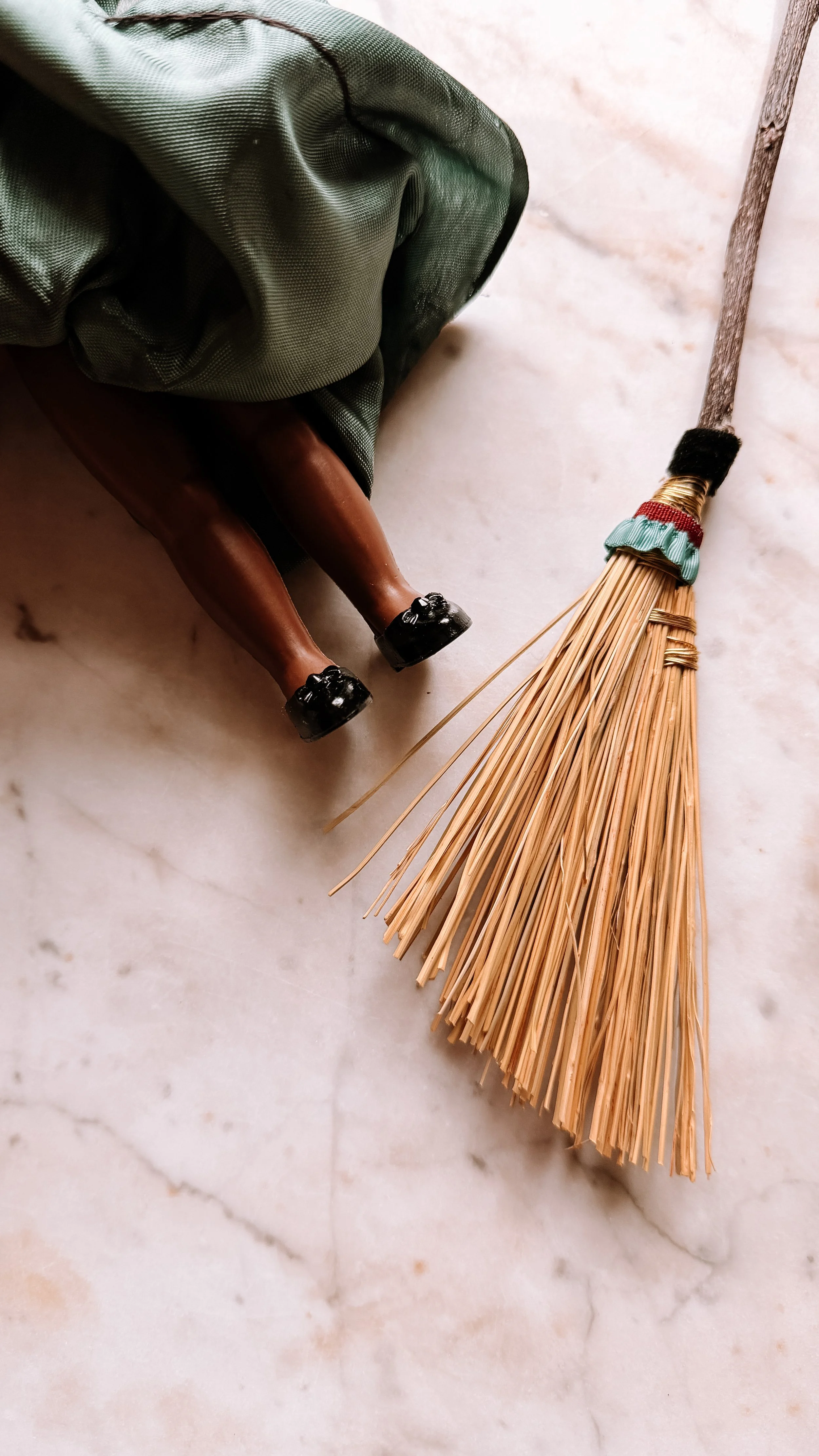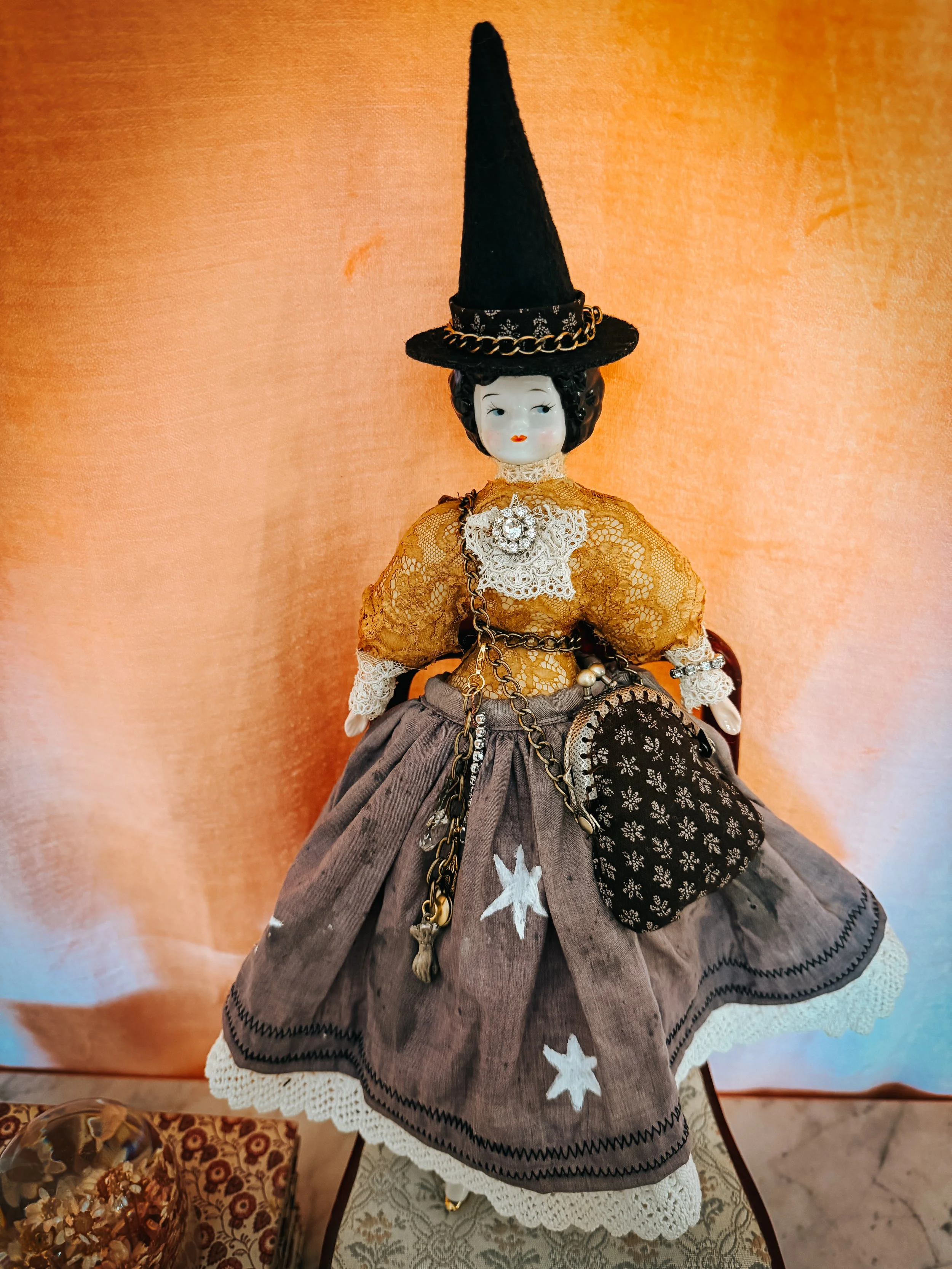 Image 1 of 12
Image 1 of 12

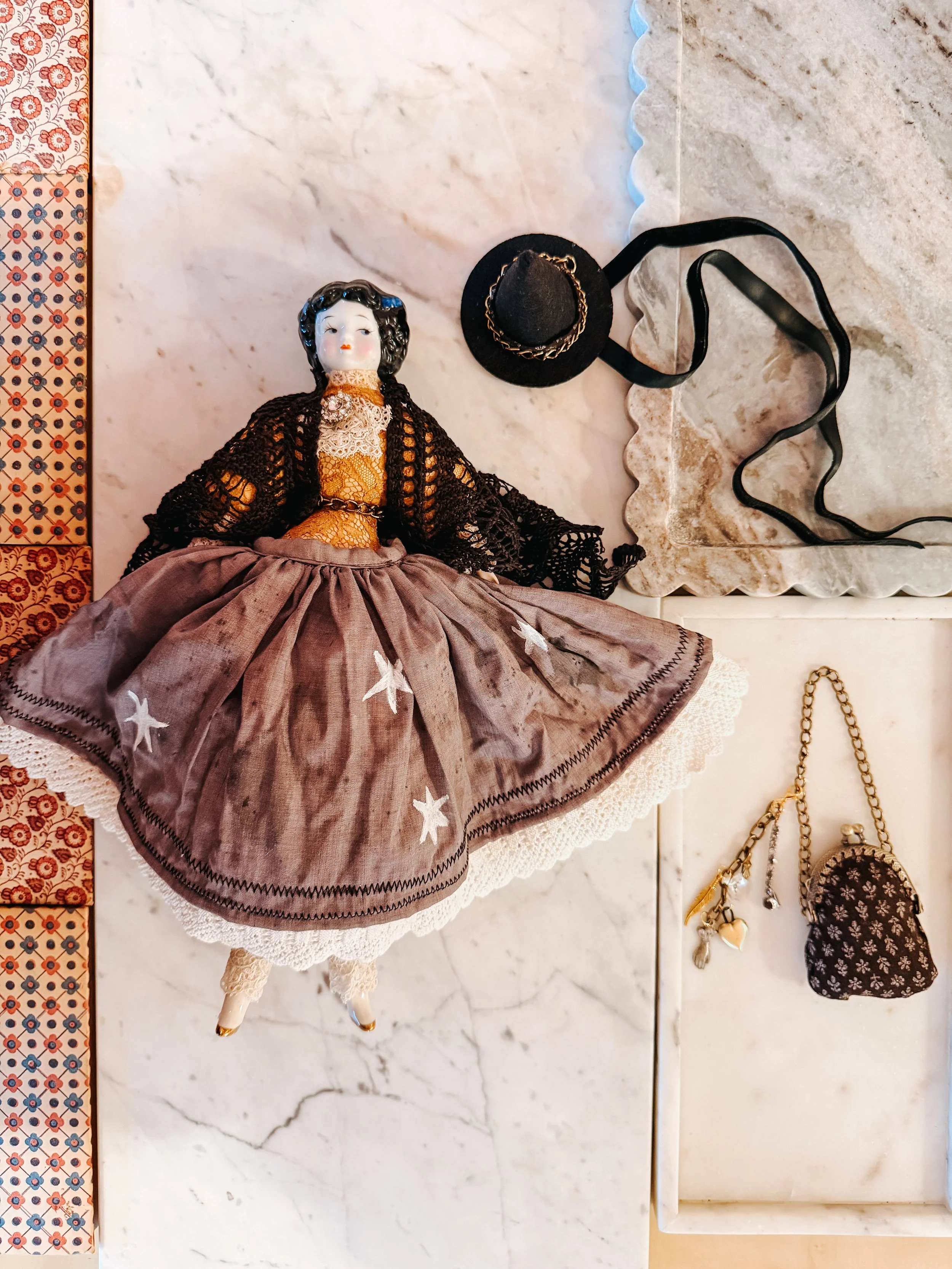 Image 2 of 12
Image 2 of 12

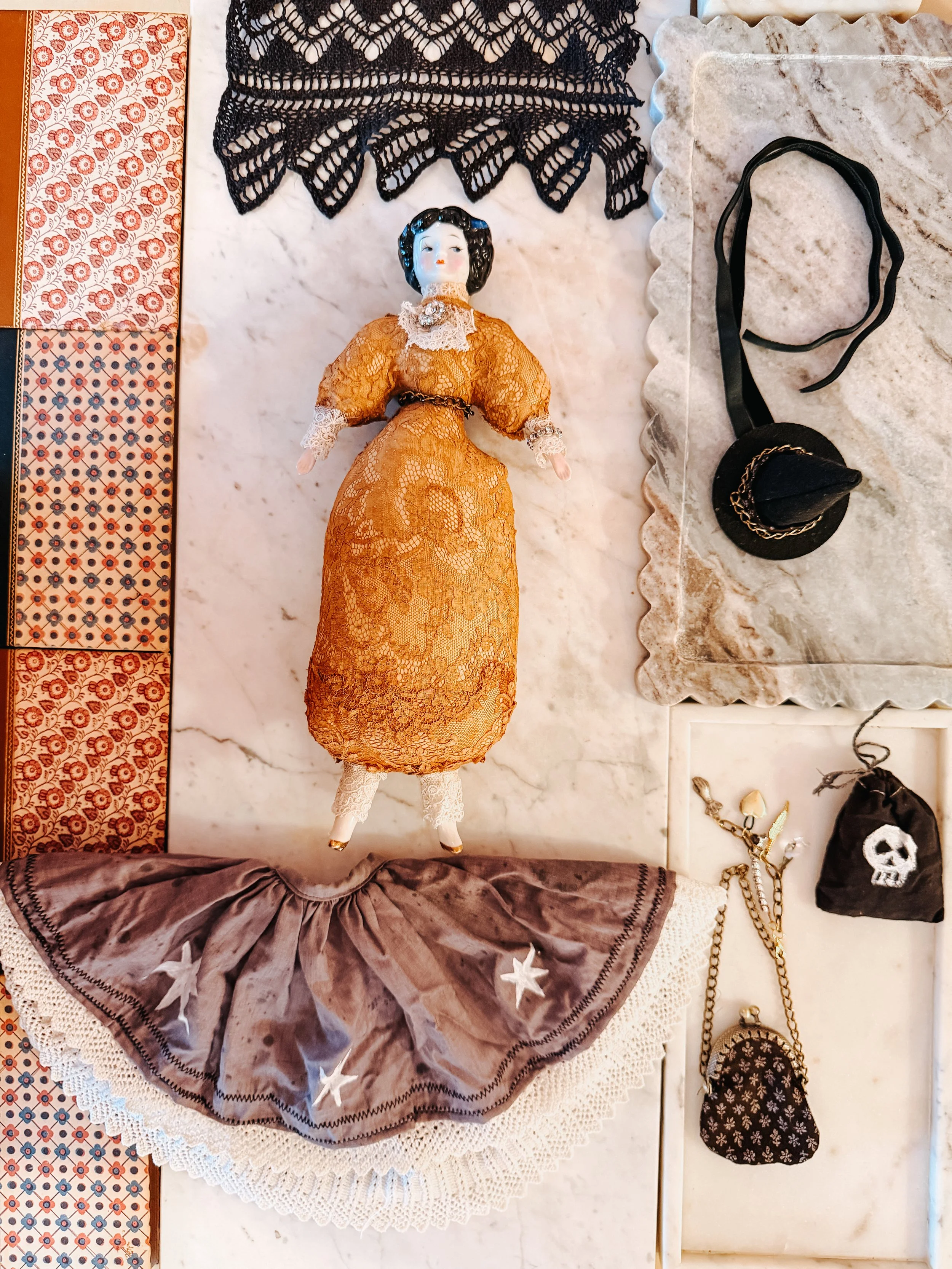 Image 3 of 12
Image 3 of 12

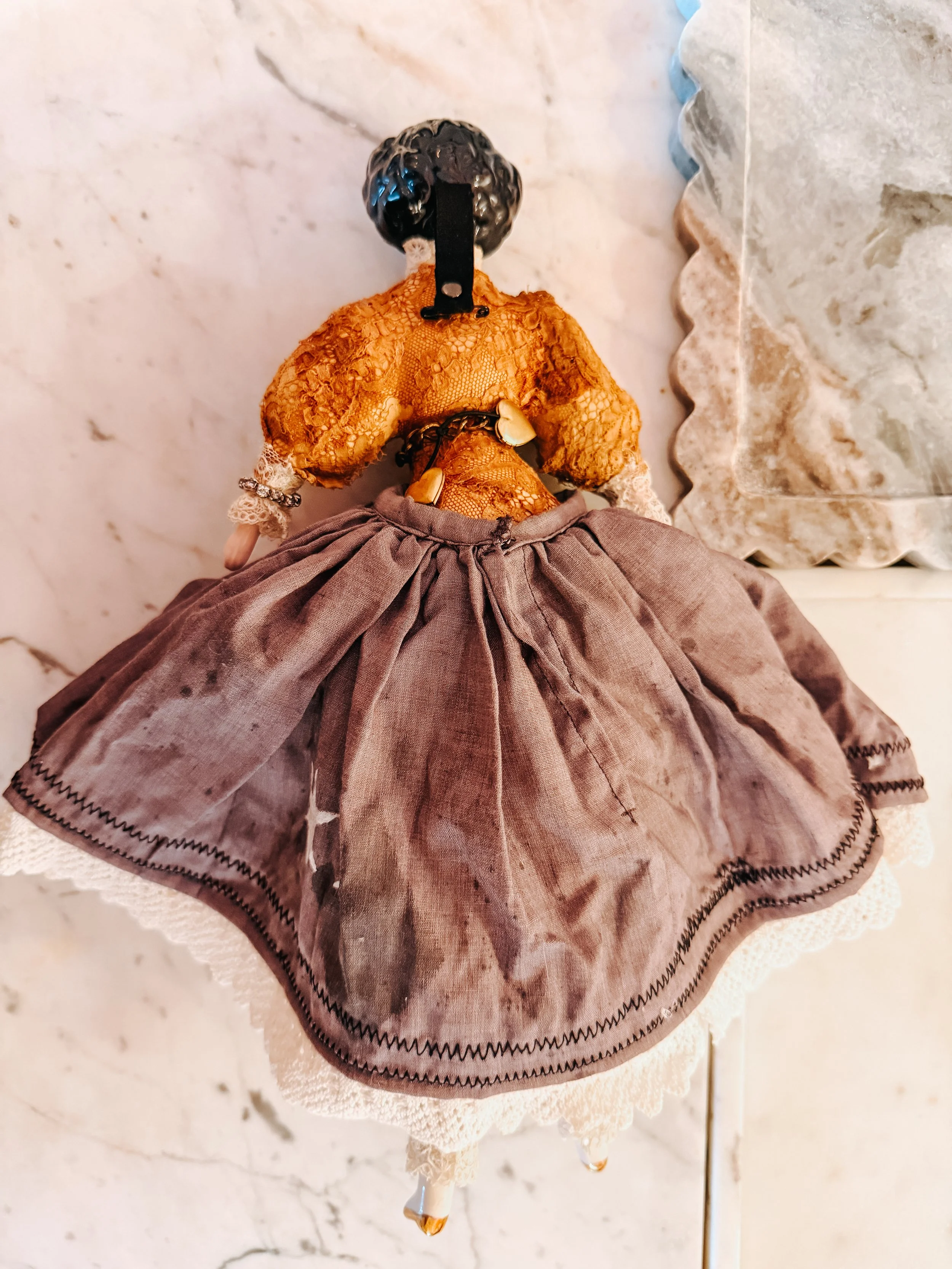 Image 4 of 12
Image 4 of 12

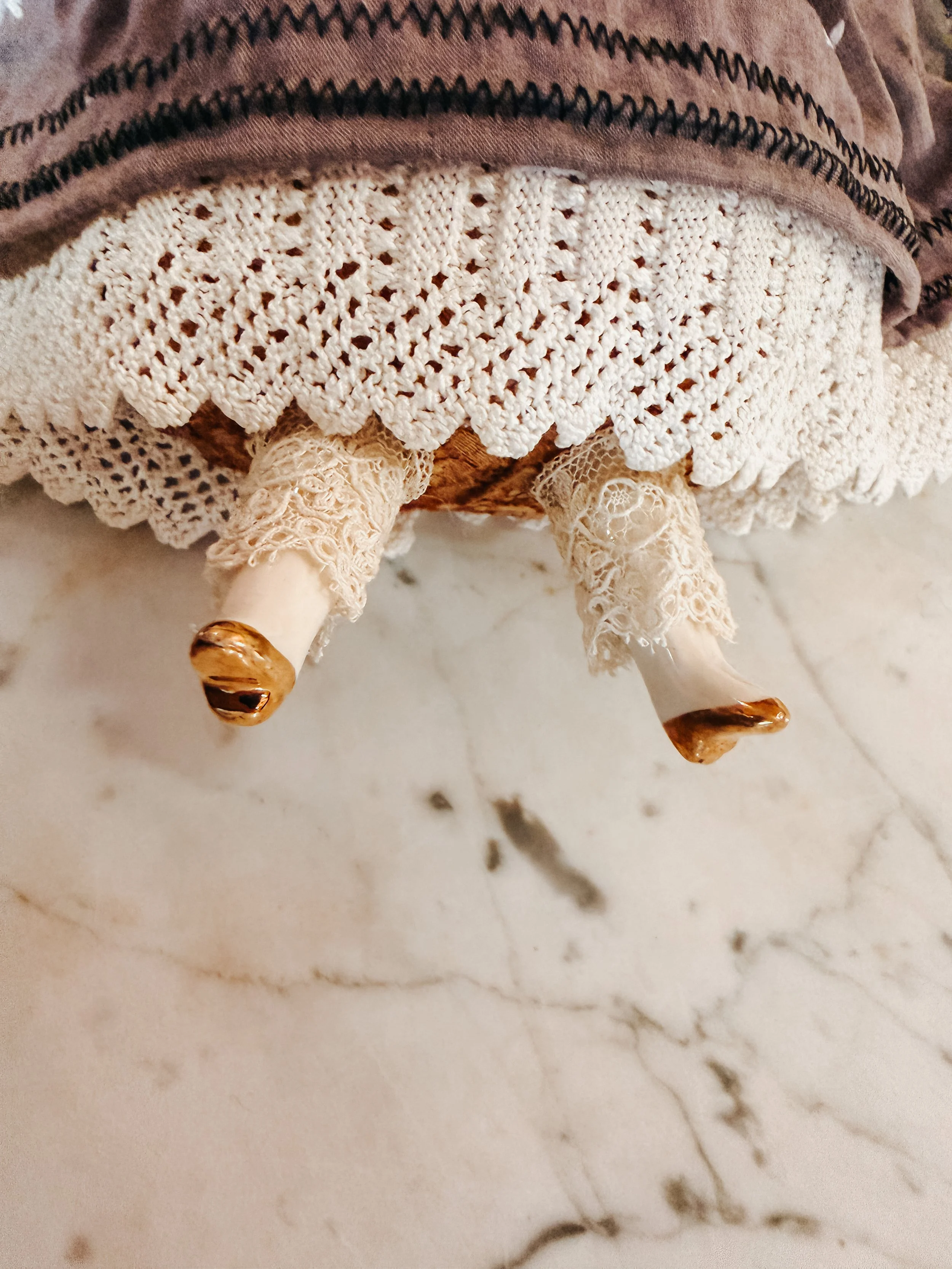 Image 5 of 12
Image 5 of 12

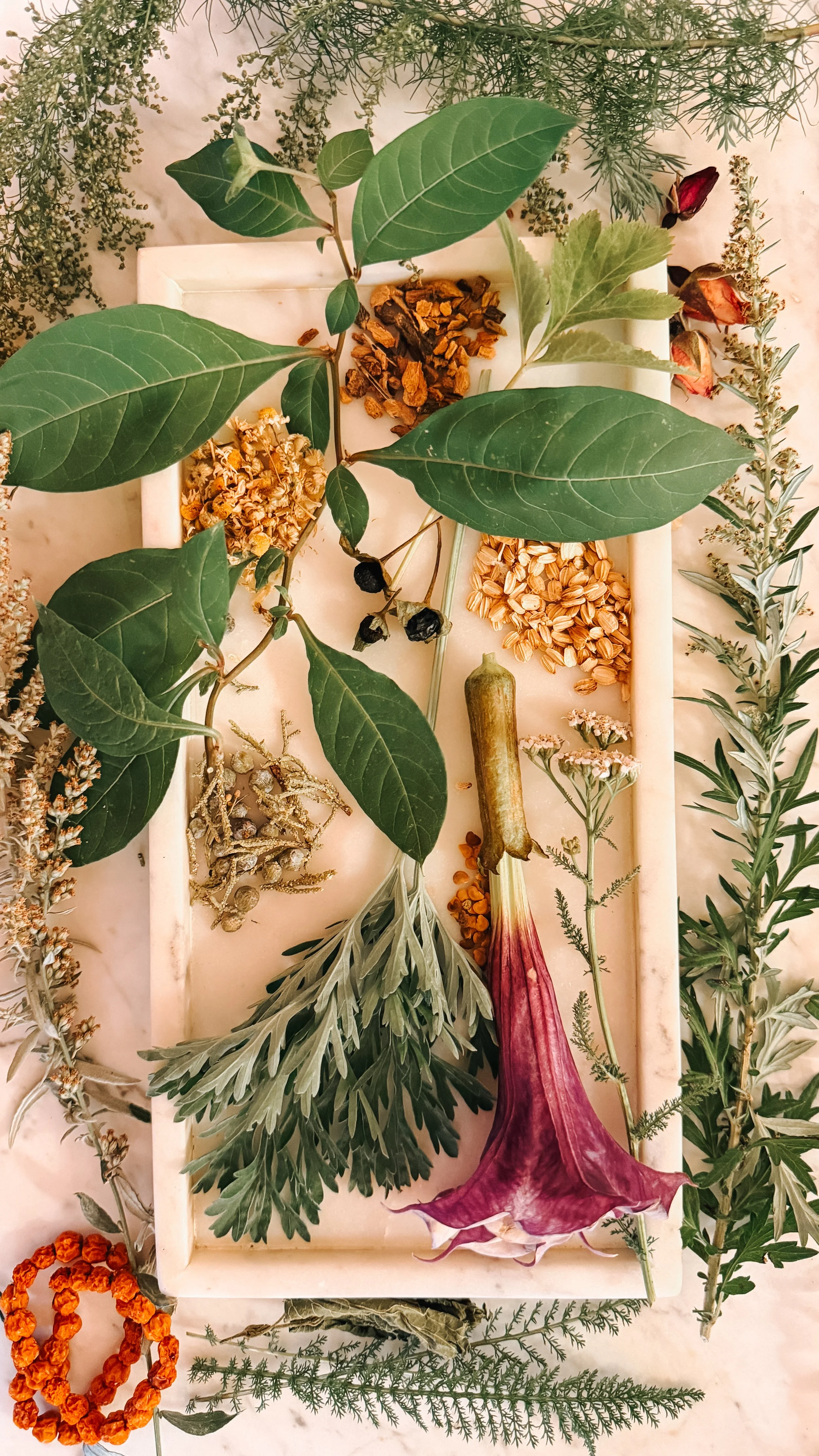 Image 6 of 12
Image 6 of 12

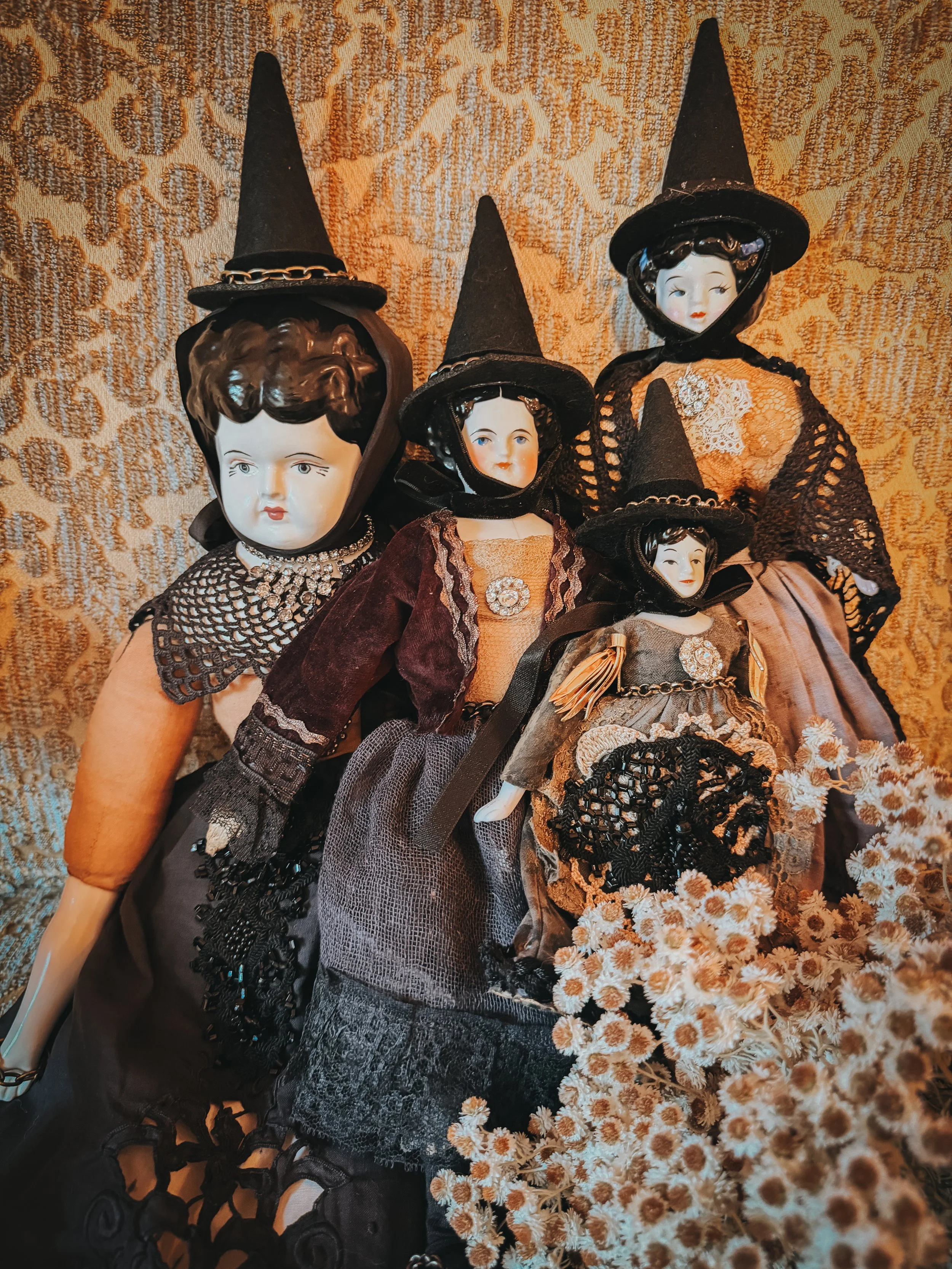 Image 7 of 12
Image 7 of 12

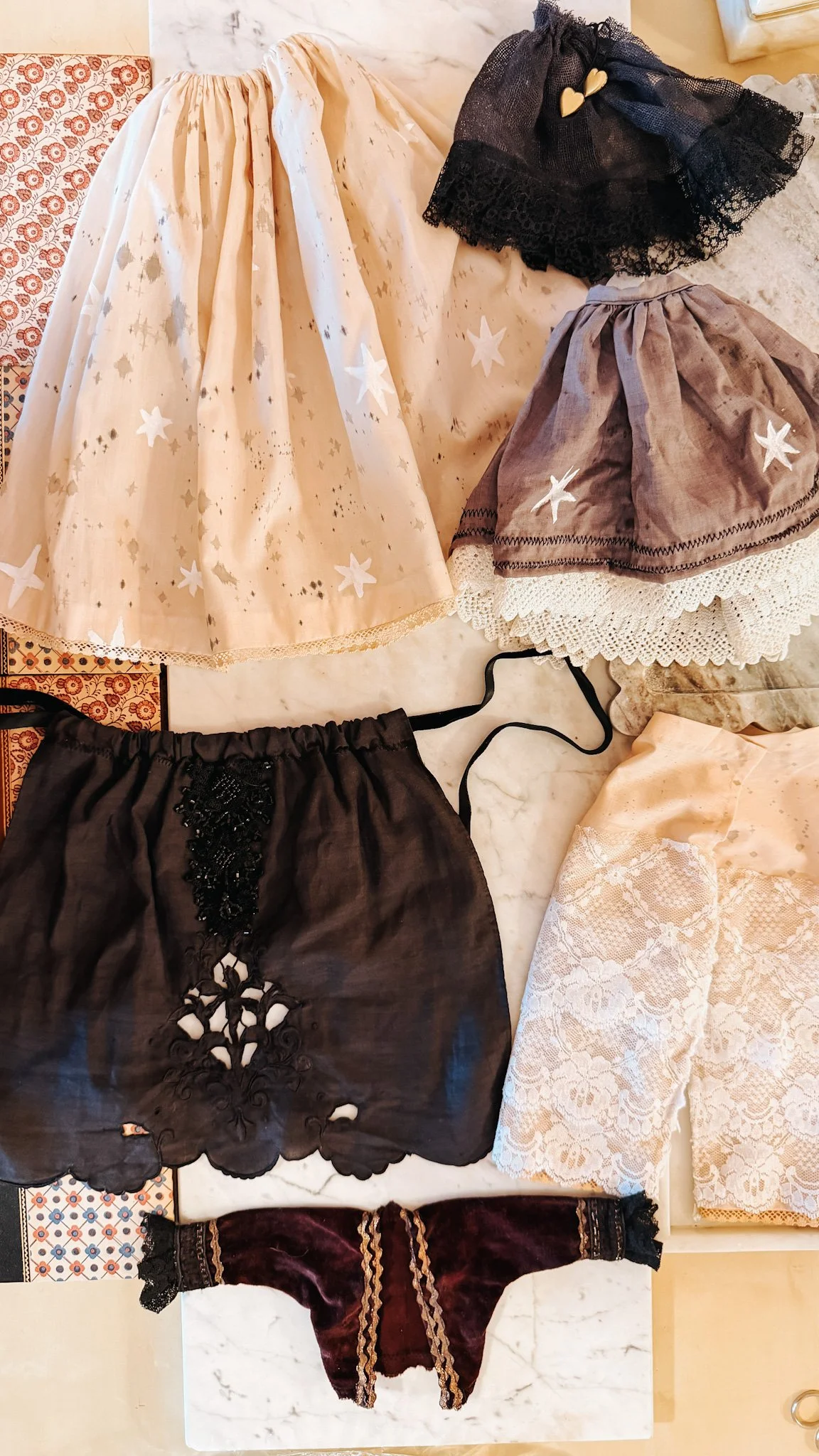 Image 8 of 12
Image 8 of 12

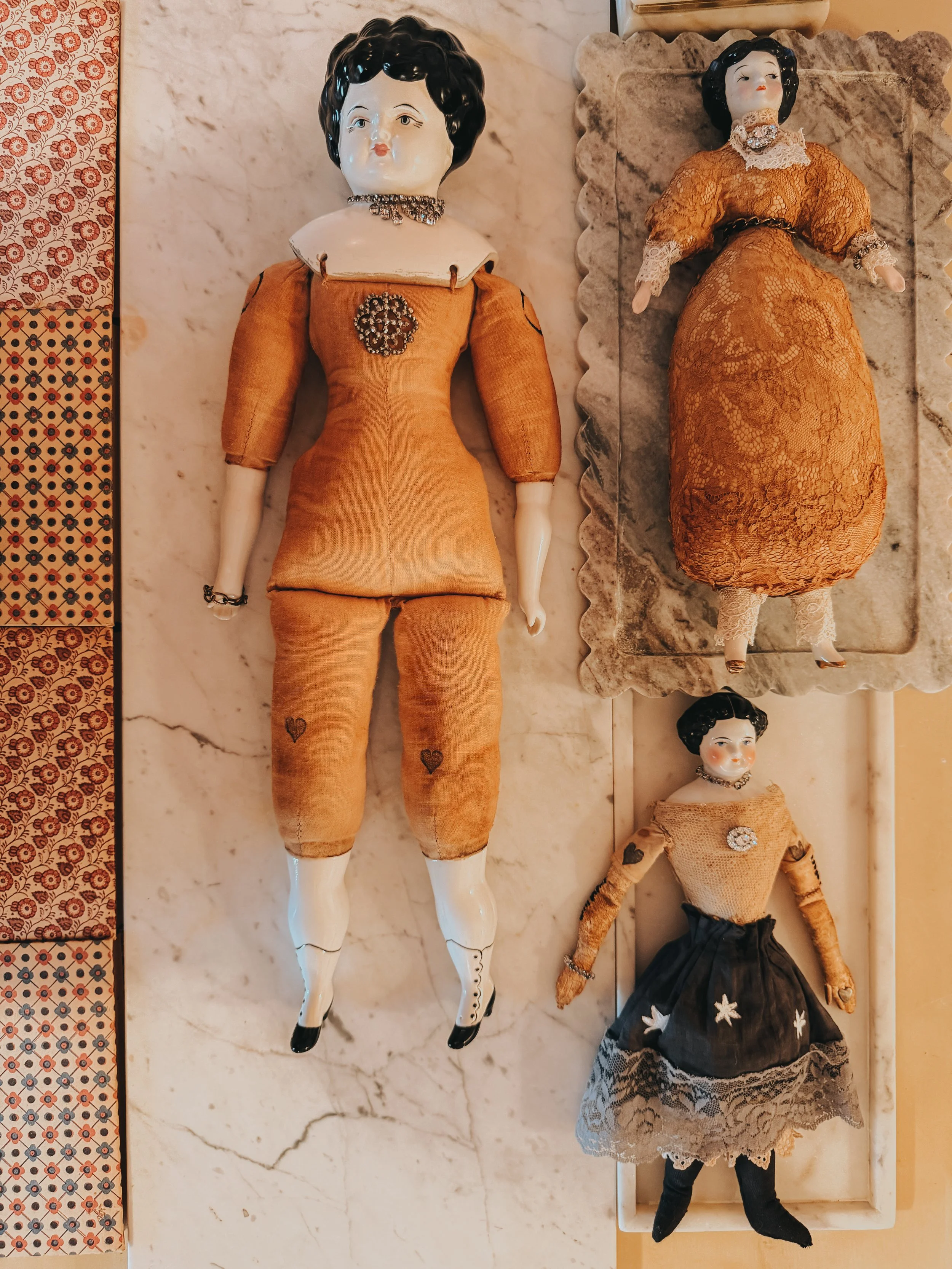 Image 9 of 12
Image 9 of 12

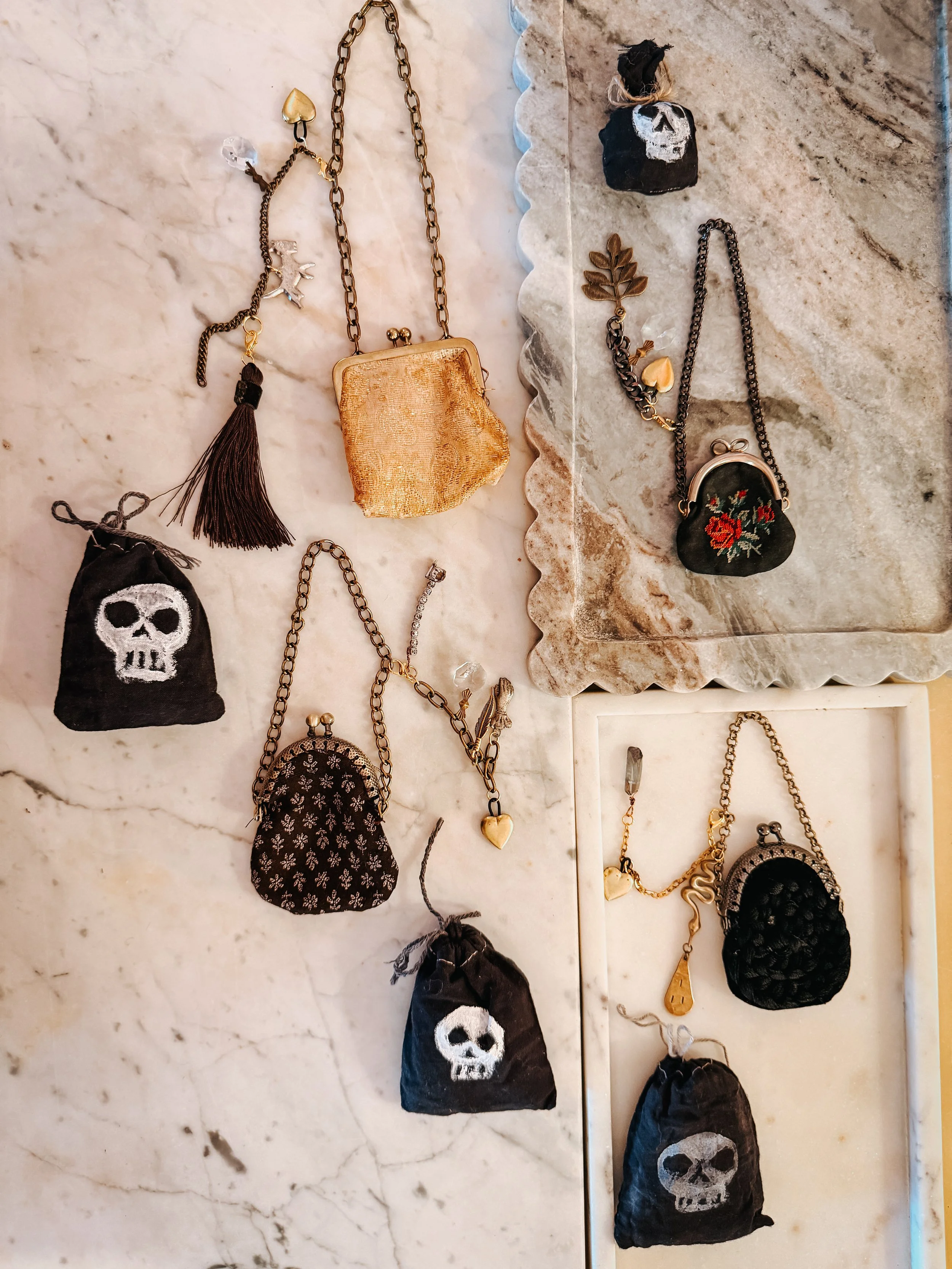 Image 10 of 12
Image 10 of 12

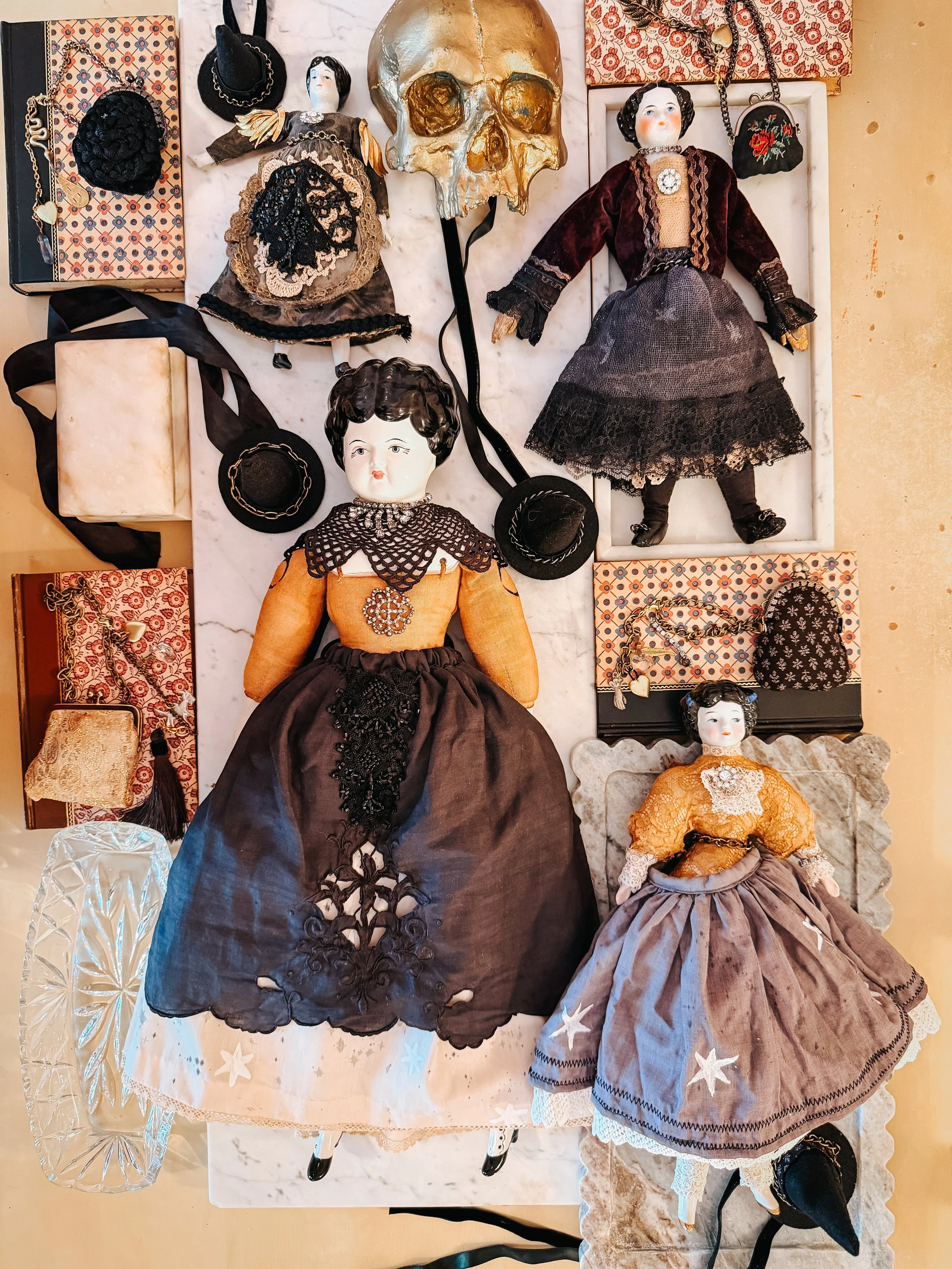 Image 11 of 12
Image 11 of 12

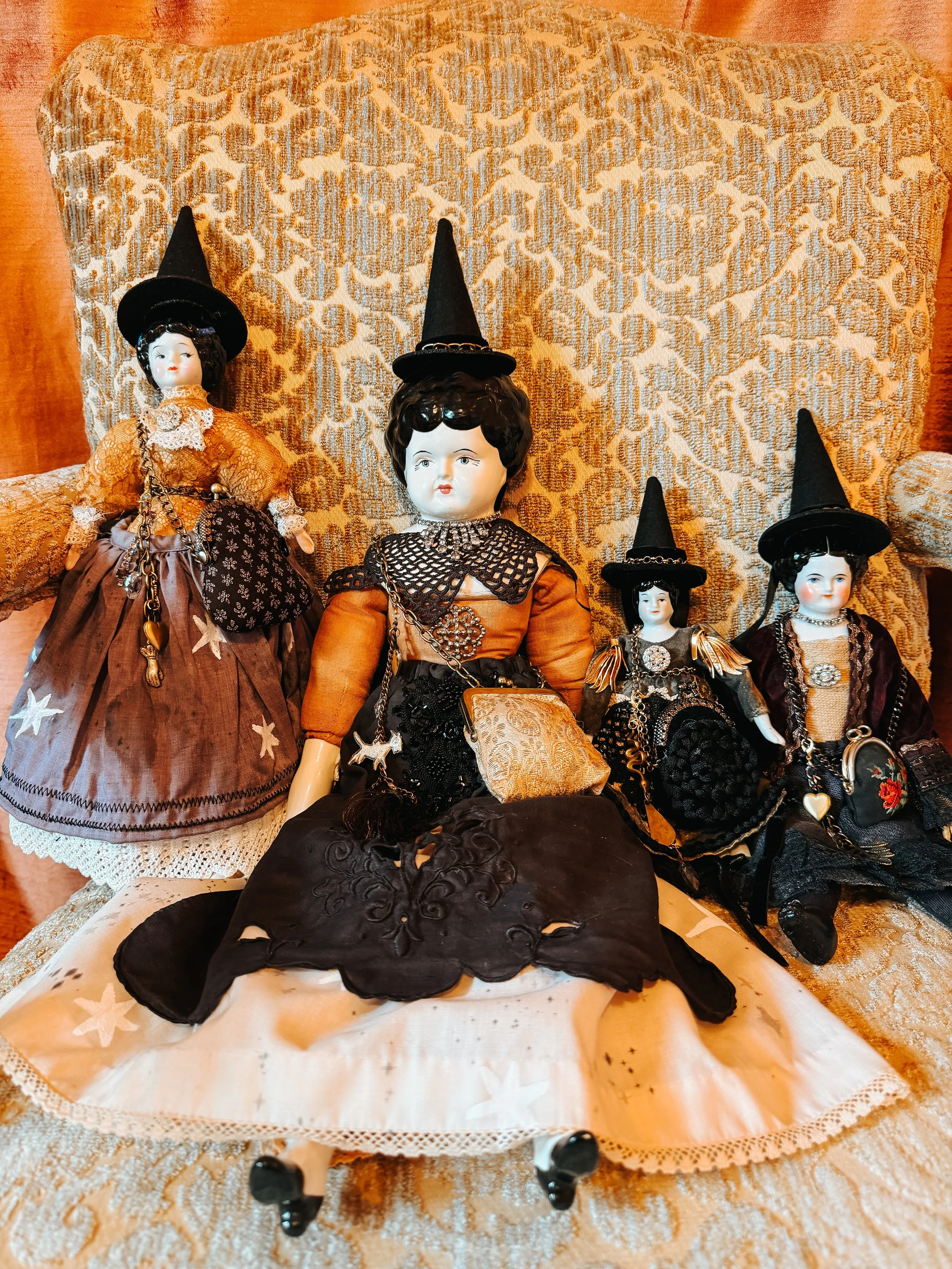 Image 12 of 12
Image 12 of 12













Elsa Couture Witch Doll
Elsa is a one-of-a-kind witch doll created from vintage 1970’s era Avon American Heritage China Head Doll in the style of the “German Low Brow” antique dolls. I have added ceramic arms and legs to her body which is covered in tea-dyed vintage lace. She has a very sly look on her face.
She is adorned with vintage lace and rhinestone button ascot. She wears a hand-dyed vintage black cotton shawl, and has a black felt hat that can be affixed with a little Gorilla putty or tied on with the velvet ribbons. Her skirt is a vintage hand-dyed doll skirt that I sewed vintage lace onto, and hand painted stars. She has a matching handmade little purse with its own purse charms, which can be detached. She wears a rhinestone bracelet and a waist chain that matches her bag full of poisonous and magical herbs.
She measures approximately 13”
Elsa can be worn “Labubu-style” on a bag or purse, but if you want to use her that way, please let me know so I can add a reinforced ribbon and a ring to attach her.
Elsa can have the poisonous plants removed from her bag if you’d prefer. There are only a couple leaves of dried belladonna and one dried datura flower, they’re not a problem to handle by adults (gloves always recommended) but they are not without risk!
Please note that some of these these plants, while generally safe to handle for short periods of time (though it’s always safest to wear gloves), can cause serious harm and can even be deadly if ingested (by a small/vulnerable being). Keep away from children and pets. Poisonous plants can be removed by request, and they do come inside their own little dyed pouch.
Here is a listing of what is included in her portable apothecary (all grown organically by me) and their properties:
Protection & Banishing
Angelica (Angelica archangelica)
Mugworts (Artemisia vulgaris, ludoviciana, californica, annua, scoparia)
Wormwood (Artemisia absinthium)
Juniper (Juniperus communis)
Rowan (Sorbus aucuparia)
Olive leaf for Gaza (Olea europaea)
Salt
Healing & Restorative
Yarrow (Achillea millefolium)
Nettle (Urtica dioica)
Chamomile (Matricaria chamomilla)
Spirit Work
Belladonna (Atropa belladonna)
Datura (Datura metel double purple)
Care & Notes:
Lore:
Elsa Thomasdotter, often called “Gamla Elsa” or “Old Elsa,” was an elderly folk healer living in Stockholm during the late seventeenth century. She was born around 1590 and lived long enough to witness Sweden’s transformation from a Catholic country to a deeply Lutheran state. By the time of the witch panic known as Det stora oväsendet - the Great Noise between 1668 and 1676 - Elsa was an old woman living in Katarina Parish, a crowded district of Stockholm where rumor and fear spread easily.
Unlike many of the accused country women, Elsa had a known role as a healer and midwife. She treated people using herbs, Christian prayers, and simple charms, relying on the kind of folk medicine that had long existed in rural Sweden. She would bless salt, mix herbs, and recite verses invoking God, Jesus, and the Virgin Mary. Her neighbors came to her for help, but her abilities also stirred suspicion. By the mid-1670s, as the witch trials reached the capital, such folk practices were enough to invite danger.
In 1676, Elsa was accused of witchcraft during the Katarina witch trials, which would become the final and most notorious episode of the Great Noise. Children and neighbors testified that she could heal with charms and powders, that she seemed to know hidden things, and that she might have assistance from unseen spirits. These were the standard accusations of the era: rooted in fear, misunderstanding, and theological paranoia rather than evidence.
When brought before the court, Elsa did not deny her healing work. She admitted she had used herbs and salt and spoken holy words over them, but insisted that her power came from God, not the Devil. “If my words and herbs have done good,” she reportedly told the judges, “it is because of God, not because of Satan.” Her age, piety, and reputation for helping rather than harming people weighed in her favor.
While several other women in the Katarina trials, such as Anna and Brita Zippel, were executed, Elsa’s outcome was different. The court convicted her of superstition (a lesser offense than witchcraft) and she was banished from Stockholm, forbidden to continue her healing work. This judgment reflected a turning point in Swedish society. The government and clergy were beginning to doubt the reliability of child witnesses and to question the frenzy that had consumed the country for nearly a decade.
Elsa Thomasdotter likely died a few years later, an old woman living quietly somewhere outside the city. She represents the last generation of Sweden’s “wise women” [Klokagummor], people who practiced traditional herbalism and Christian folk magic. Her trial marks the fading of the old belief that every act of healing beyond church doctrine must be the Devil’s work, and the beginning of a more skeptical, secular age.
Lineage:
Plants are grown by me and are incorporated in accordance with my own ancestral traditions, especially from the documents in the Svartkonstböcker: A Compendium of the Swedish Black Art Book Tradition. However, most of these plants had ritual and magical uses across Old Europe and beyond. Feel free to add herbs, stones, talismans, etc. of your own.
Care:
This doll is in excellent condition but she does have fragile, ceramic parts and is for display not play. Do not get her or her clothing wet, and keep out of direct sunlight.
Legal:
Botanicals are offered for ritual, craft, and educational purposes in the spirit of traditional folk magic and herbal lore only. They are not intended to diagnose, treat, cure, or prevent any illness or medical condition. Certain plants are poisonous and/or toxic and are provided only for external, ritual, or collector use. Anyone allergic to nightshades should not handle these herbs. These items are not for internal use, ingestion, or medical application. By purchasing, you agree to handle all materials with care and assume full responsibility for their safe and lawful use.
Elsa is a one-of-a-kind witch doll created from vintage 1970’s era Avon American Heritage China Head Doll in the style of the “German Low Brow” antique dolls. I have added ceramic arms and legs to her body which is covered in tea-dyed vintage lace. She has a very sly look on her face.
She is adorned with vintage lace and rhinestone button ascot. She wears a hand-dyed vintage black cotton shawl, and has a black felt hat that can be affixed with a little Gorilla putty or tied on with the velvet ribbons. Her skirt is a vintage hand-dyed doll skirt that I sewed vintage lace onto, and hand painted stars. She has a matching handmade little purse with its own purse charms, which can be detached. She wears a rhinestone bracelet and a waist chain that matches her bag full of poisonous and magical herbs.
She measures approximately 13”
Elsa can be worn “Labubu-style” on a bag or purse, but if you want to use her that way, please let me know so I can add a reinforced ribbon and a ring to attach her.
Elsa can have the poisonous plants removed from her bag if you’d prefer. There are only a couple leaves of dried belladonna and one dried datura flower, they’re not a problem to handle by adults (gloves always recommended) but they are not without risk!
Please note that some of these these plants, while generally safe to handle for short periods of time (though it’s always safest to wear gloves), can cause serious harm and can even be deadly if ingested (by a small/vulnerable being). Keep away from children and pets. Poisonous plants can be removed by request, and they do come inside their own little dyed pouch.
Here is a listing of what is included in her portable apothecary (all grown organically by me) and their properties:
Protection & Banishing
Angelica (Angelica archangelica)
Mugworts (Artemisia vulgaris, ludoviciana, californica, annua, scoparia)
Wormwood (Artemisia absinthium)
Juniper (Juniperus communis)
Rowan (Sorbus aucuparia)
Olive leaf for Gaza (Olea europaea)
Salt
Healing & Restorative
Yarrow (Achillea millefolium)
Nettle (Urtica dioica)
Chamomile (Matricaria chamomilla)
Spirit Work
Belladonna (Atropa belladonna)
Datura (Datura metel double purple)
Care & Notes:
Lore:
Elsa Thomasdotter, often called “Gamla Elsa” or “Old Elsa,” was an elderly folk healer living in Stockholm during the late seventeenth century. She was born around 1590 and lived long enough to witness Sweden’s transformation from a Catholic country to a deeply Lutheran state. By the time of the witch panic known as Det stora oväsendet - the Great Noise between 1668 and 1676 - Elsa was an old woman living in Katarina Parish, a crowded district of Stockholm where rumor and fear spread easily.
Unlike many of the accused country women, Elsa had a known role as a healer and midwife. She treated people using herbs, Christian prayers, and simple charms, relying on the kind of folk medicine that had long existed in rural Sweden. She would bless salt, mix herbs, and recite verses invoking God, Jesus, and the Virgin Mary. Her neighbors came to her for help, but her abilities also stirred suspicion. By the mid-1670s, as the witch trials reached the capital, such folk practices were enough to invite danger.
In 1676, Elsa was accused of witchcraft during the Katarina witch trials, which would become the final and most notorious episode of the Great Noise. Children and neighbors testified that she could heal with charms and powders, that she seemed to know hidden things, and that she might have assistance from unseen spirits. These were the standard accusations of the era: rooted in fear, misunderstanding, and theological paranoia rather than evidence.
When brought before the court, Elsa did not deny her healing work. She admitted she had used herbs and salt and spoken holy words over them, but insisted that her power came from God, not the Devil. “If my words and herbs have done good,” she reportedly told the judges, “it is because of God, not because of Satan.” Her age, piety, and reputation for helping rather than harming people weighed in her favor.
While several other women in the Katarina trials, such as Anna and Brita Zippel, were executed, Elsa’s outcome was different. The court convicted her of superstition (a lesser offense than witchcraft) and she was banished from Stockholm, forbidden to continue her healing work. This judgment reflected a turning point in Swedish society. The government and clergy were beginning to doubt the reliability of child witnesses and to question the frenzy that had consumed the country for nearly a decade.
Elsa Thomasdotter likely died a few years later, an old woman living quietly somewhere outside the city. She represents the last generation of Sweden’s “wise women” [Klokagummor], people who practiced traditional herbalism and Christian folk magic. Her trial marks the fading of the old belief that every act of healing beyond church doctrine must be the Devil’s work, and the beginning of a more skeptical, secular age.
Lineage:
Plants are grown by me and are incorporated in accordance with my own ancestral traditions, especially from the documents in the Svartkonstböcker: A Compendium of the Swedish Black Art Book Tradition. However, most of these plants had ritual and magical uses across Old Europe and beyond. Feel free to add herbs, stones, talismans, etc. of your own.
Care:
This doll is in excellent condition but she does have fragile, ceramic parts and is for display not play. Do not get her or her clothing wet, and keep out of direct sunlight.
Legal:
Botanicals are offered for ritual, craft, and educational purposes in the spirit of traditional folk magic and herbal lore only. They are not intended to diagnose, treat, cure, or prevent any illness or medical condition. Certain plants are poisonous and/or toxic and are provided only for external, ritual, or collector use. Anyone allergic to nightshades should not handle these herbs. These items are not for internal use, ingestion, or medical application. By purchasing, you agree to handle all materials with care and assume full responsibility for their safe and lawful use.
